| FAQs about Health/Disease of Tangs 13
FAQs on: Tang Disease 1, Tang Disease 2, Tang
Disease 3, Tang Disease 4, Tang Disease 5, Tang Disease 6, Tang Disease 7, Tang Disease
8, Tang Health
9, Tang
Disease 10, Tang Disease 11,
Tang Disease 12,
FAQs on Tang Disease by Category:
Diagnosis,
Environmental, Nutritional,
Social, Trauma,
Pathogenic (plus see below),
Genetic,
Treatments
FAQs by Tang Disease by Pathogen: Tangs/Rabbitfishes & Crypt, Tangs/Rabbits Crypt 2, Tangs/Rabbits Crypt 3, Tangs/Rabbits Crypt 4, & Paravortex/Black Spot Disease,
Related Articles:
The Surgeonfish family,
Acanthurus,
Ctenochaetus, Naso, Paracanthurus,
Zebrasoma , Prionurus, Surgeonfishes of Hawai'i, Surgeonfishes for Reef Systems,
Related FAQs:
Tangs in
General, Tang ID, Selection, Tang Behavior, Compatibility, Systems,
Feeding,
Treating Marine Disease,
Marine Diseases 2,
|
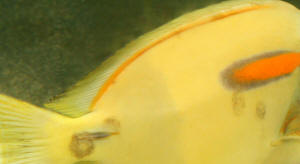
|
Surgeonfishes: Tangs for Marine Aquariums
Diversity, Selection & Care
New eBook on Amazon: Available here
New Print Book on Create Space: Available
here
by Robert (Bob) Fenner |
 |
Vampire tang - sudden illness - potentially due to high
temperature 11/22/19
Good Afternoon team,
<Hi Millezanne>
hope you are well.
<Mostly yes, thanks>
Last time around you were of the greatest help so thought you might have
some valuable advice with my sick tang.
Tank set up and parameters: Red sea reefer 350, skimmer Bubble Magus
Curve 5, 2 x250 watt heaters, wave maker. FOWLR system with live rock
(25kg), 2 x da Vinci clownfish (1 inch) and a vampire tang (3 inches), 1
hermit crab, 1 cleaner shrimp, few snail, free critters on live rock,
temp usually around 27-29 degrees Celsius (summer in south Africa, so a
bit hotter than normal this time of year) ammonia 0, nitrite 0, nitrate
15.
Tank has been running for about 2 years. Last fish added in January
2018.
We just moved, moved the tank as is within about 2 hours, this was about
3 weeks ago.
I think my one heater failed. I looked at my tank and only saw the
clownfish, the tang (2 years in my tank) usually all over the tank was
missing. I found her at the back of the tank, she turned herself black
and had spots here and there. Breathing really fast and badly. I felt
the water temp with my hand and it was hot! Checked thermometer and its
35-36 degrees
Celsius.
<Yikes!>
Clowns did not react at all, no change in appearance or behaviour. Not
seeing my crustaceans, hope they ok.
18 hours ago everyone was happy and there were no signs of stress in the
tank.
I immediately grabbed all the wine and other liquid in the fridge and
floated in the tank.
<Hope you drank part of it !>
I got it down to 34, then 33 eventually stabilized around 29 degrees. As
the sun set its now at 26-27 degrees
Also increased water flow, did a water change with colder water and added
a fan to the sump.
<Good moves>
Tang is looking better but far from healthy, see video, she is back to
normal colour and not hiding anymore. More active than earlier. She is
not eating not sure what to do next.
<Be patient, the tang is very stressed to eat, give it time>
Thought temp was the only issue now I think she might have white spot as
well, not sure. Fish was 100% healthy half a day ago. There is a pattern
on her forehead with white spots, skin affected, also fin damage. Not
sure what caused it.
<Apparently it got hit with something>
I dosed the tank with seachem Metroplex, what I had around.
<You shouldn’t have medicated the tank, this will only add stress to the
livestock and you don't know yet if any is sick.>
Fish already stressed so did not want to attempt a fw bath etc.
What would you suggest as to treatment? Any idea what to do to save my
tang?
<I suggest dimming the lights until everything settles down, also do
keep an eye on the temperature and avoid drastic changes.>
Kind regards,
Millezanne
<Cheers. Wil.>
Re: Vampire tang - sudden illness - potentially due to high temperature
11/22/19
Thank you,
<Welcome>
She looks a little better this morning (its 5am in South Africa) still
breathing heavily. Water temp at 25 degrees. I dimmed lights as you
suggested.
<Good>
Can you maybe elaborate on what the discoloration on her forehead is?
Not sure this is a physical injury, attached another video of last
night, no visibility now without lights, it is still discolored and skin
seems to peel at ends of this. It recovered slightly overnight, last 6
hours.
<Could be just its protective slime coat peeling off, or could be
something else>
Also definitely seeing spots around this area on the fish and on mouth.
<Mmm... I suggest to dip/bath this fish for 5 minutes in freshwater
w/Methylene blue, same ph and temperature as in the main tank, and
provide an air stone to oxygenate while dipping; this should help to get
rid of any dead tissue and possible parasites.>
She is swimming better this morning doing her usual route in the tank.
<That’s a good sign>
Hi, got a better pic of this. Video of discoloration on tang, is this an
illness or could it subside by itself? Not sure if she is getting
better.
Temp still at 25 degrees.
<Dip/bath as I mentioned and if symptoms persist you may have to treat
it in a separate tank.>
Apologies, better quality visual attached.
<Please send us just the link to the video, which could be placed in the
cloud or YouTube; our server has limited space and crashes when we
receive very large files. Cheers. Wil.>
Re: Vampire tang - sudden illness - potentially due to high
temperature
12/5/19
Hi,
<Hi>
Thanks for the previous advice, much appreciated.
<You’re welcome>
My Tang pulled through, been quite a long sickbed though. The wound on its
forehead became rawer. At times she was looking quite bad. See progress
pictures. 21 Nov, 22 Nov,24 Nov, 30 Nov (Saturday) and Today.
https://drive.google.com/folderview?id=18I4_jZ2ag_LXjsRfxvTnGMmnfUqxw2Eg
<I see it is getting better>
Apart from the massive wound on her forehead she also developed pop eye over
this period.
I did 2 x 25% water changes in this period and after not being able to do catch
her for a dip suggested, she recovered.
<Does look like a significant improvement over the course of these days>
I also removed activated carbon, a faulty heater that caused the temp spike in
this time and I widened her rock caves when she got the pop eye as I could see
her squeezing herself into tiny spaces.
<Good>
(We moved this tank about a month ago to our new house) fish movers did a great
job but did not redo the tang’s cave similar to what it was, new caves were
tiny, and she did not fit.
Nowy <Nosy?> question - illness cleared up, pop eye cleared up and wound healed
very well except for a harry potter like scar left. Problem is the tang still
seems very traumatized and has only eaten on 4 occasions in the last 2 weeks.
She has had 4 meals of which 2 was on the same day That was about
a week ago. At the moment she nips at glass and green algae in tank, refuses all
food I feed. Hides if I add food or don’t hide and ignores the food she loved
before (formulae 1 pellets and flakes) she still eats algae from the glass.
Mysis and frozen foods - I tried feeding that she never really looked at this
always spitted this out previously but now nips at it when feeding but spits out
every piece. She has eaten a little bit of algae from the glass and maybe 1
flake. She does not show interest in food at all. she previously hated garlic in
food, I haven’t tried this yet.
She can still see well. She nips with precision at the frozen food.
She swims around in tank but mainly stays close to her new large cave that I
built now when she was sick.
Her color also concerns me, the last photo the almost black Color is her angry
“make up” or pajamas
- she turns this color when I added her to display for the first time. And
subsequently only rare occasions and would turn back to normal color in minutes.
She has been this color for 5 days now.
<The dark coloration is common on stressed fish, mostly on recently imported,
and yours has been through similar stress with the tank moving and the extreme
temperature variation.>
Also seems to be some aggression between her and the one clown. She keeps
flexing her top fin at clown.
I removed clown for a day, and she reacted the same.
Can you please share any tips on how to get her happier and to get her to eat?
Nothing seems to work. I try switching off the pump to feed her to get food
closer to when she was sick, it did work a few times but now it doesn’t.
I’m not cleaning algae off the glass, so she has more to eat/nip at. Tank looks
terrible but its fine if she eats it.
Also been trying different foods suspect I’m over feeding due to this, but the
25% water changes cancelled it out as readings ammonia, nitrite, nitrate still
zero.
<I wouldn’t worry about the tang not eating (for now), fit fish like yours may
go for a few weeks without food, your tang doesn’t look emaciated. I suggest
focusing more on environmental conditions and reducing stress, if water changes
helped to improve it’s health, go that route, maybe not large water changes but
10-15% twice a week, add vitamin supplements directly to the tank water and
avoid putting your hands in the tank as much as possible, after all it has been
through, the tang is very stressed and your presence is not well taken now,
these are very shy fish.>
One other thing there is Aiptasia in the tank, could this be bothering the tang?
<Not necessarily, but it appears when there are excess nutrients in the water,
commonly caused by overcrowded or not large enough tanks in relation to the
livestock, insufficient skimming and infrequent water changes.>
Your advice so much appreciated thanks!
<Glad to help, but next time please help us to check/fix your spelling/grammar
ahead of sending your query, I did it for you this time. Cheers. Wil.>
Fin issue 7/22/19
Hey bob,
<B>
Having trouble determining if my fish’s tethered fins are bite marks or fin rot.
<Can look very similar>
Make a long story short, I asked my lfs to bring in a small mustard tang. He
did, was there 5 days, and ate strong the day I saw him.
<This species can be tricky to ship, acclimate to captive conditions>
As he was going to net him out, I noticed some portions of his back tail look
jagged. As if someone took a pair of scissors and cut marks out up and down back
tail.
I have him in qt, with copper as a preventative I’ve been using before going in
display. Had him since yesterday, ate great yesterday, but not sure whether to
let it go, or treat with kanamycin.
<I'd expedite this fish to your main/display... not much to gain by copper
exposure, delay>
I will try to get a photo later today, but I hate to lose a $200 fish. Hindsight
tells me I should have left him, but I felt obligated , being I asked to bring
him in, when he normally doesn’t stock this fish.
Is their a general rule used to determine whether it infection or other fish
just not playing nice?
<Species, size... origin of collection et al. specific, influenced>
Thanks , Bobby
<W. B>
|
Tomini tang mouth injury
5/15/19
Good morning,
<Morning Cindy>
This Tomini tang has been in my 75-gal reef for about a year and a half with no
issues. I noticed yesterday that he was hiding in the rocks and didn’t come out
for Nori as usual. During last evening’s feeding he chased food and tried to eat
but his mouth seems stuck open and maybe a little swollen – it’s hard to say.
<Could be a physical trauma or something stuck in its mouth>
Today he is swimming in the open in a sort of bobbling fashion. His fins are
clamped (I think), he is clearly in some sort of distress. Not picking the rocks
or glass at all. Tankmates are several different species of wrasse, a recently
added Eibli angelfish (I have not seen the two interact much, they have avoided
each other though the Eibli has been aggressive toward other tankmates), a
couple clownfish. Some smaller, innocuous fish, a BTA and a mini carpet ‘nem.
There are no other signs of disease – no spots, gills not red, etc. All other
tankmates behaving as usual.
<How about your water quality, maintenance practices...sometimes (more than we
thought) it could be environmental>
I’m concerned, clearly he’s in distress and the other fish (notably 2 of the
wrasses and the angel) keep swimming by him.
<Are you sure these fish are not bothering the tang at all?>
I am hesitant to remove and stress him further unnecessarily but don’t want
anyone to get hurt.
<I recommend you reduce stress by dimming the lights for a couple of days and
see if condition is reverted, also try feeding with Spectrum 1mm pellets,
perhaps it will be easier for the tang to swallow than the Nori until it resumes
normal feeding.>
Also, if there is treatment I would initiate it but not sure what, if any.
<I wouldn’t treat, there are no clear signs of a disease.>
Please share your thoughts.
Gratefully, Cindy
<Hope this helps, Cindy. Wil.>
|
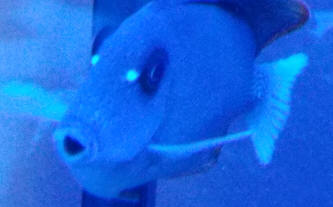 |
|
Re: Tomini tang mouth injury
5/16/19
Thank you for the suggestions I turned the lights down to less than half, and
fed some 0.5 and 1.0 mm Spectrum. The Tomini definitely was able to get a couple
of the 1.0 mm so I will continue with that for a couple of days. His swimming
seems improved and his fins less clamped, so that’s good I guess.
<Ahh good>
I don’t suspect aggression from the wrasses, they have all been in the tank
together since I got the Tomini well over a year ago (ish). The Eibli, however,
is new and is quite the jerk.
<Could be>
I’ll be re-homing him soon. I haven’t seen him go after the tang, and the tang
is quite a bit larger, but I wouldn’t be surprised.
I have been suffering coral losses for several months without knowing a cause so
SOMETHING is going on regarding water quality but I’ll be darned if I can figure
out what it is. I test Alk, Ca, Mg, NO3, PO4 weekly or more and they are all
within generally accepted limits for a reef tank. I mailed off a test, the only
really notable outliers were low Iodine and Boron and high Lithium. I am strict
with my 15% weekly water changes. If there is something amiss with my water
quality, I can’t find it ☹
<Have you tried with another test kit? Reagents go bad with time and give
erroneous readings, temperature and salinity also play an important role in the
health of corals. >
As always, thank you for sharing your knowledge. I will update if any changes.
Cindy
<You’re welcome Cindy, do please keep us posted. Wil.>
|
|
Your opinion needed 3/28/19
Hello Crew!
Can anyone explain what is on the side of this Sailfin Tang??
It was with other tangs squabbling. Could it be injuries???
<Possibly; some sort of irritation otherwise... See WWM re Zebrasoma disease>
Thanks for your reply.
Jim Jesko
<Next time; (more) data, less file size. Bob Fenner>
|
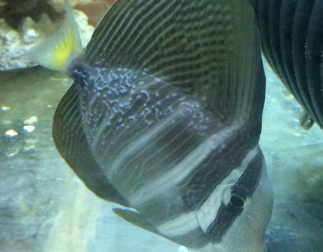 |
|
Patches on Sailfin tang /Wil 3/27/19
Hi Team,
<Hi Bodh>
I need your help in identifying the problem and solution for my sailfin tang
Just look at the picture please.
In display tank and water parameters are all fine.
<Numbers please;....other tank mates?>
She is eating like a pig. Does not look like a ICH.
<You’re right, it is not Ich>
It was in QT tank with ammonia slights high (.25 ppm) for 4 days.
<Ammonia can burn fish skin easily even if exposed for a brief period of time.>
What can be the issue ?
<Likely stress, please read the following:
http://www.wetwebmedia.com/strpzebtgdisf.htm>
Does she needs medication ? If yes which one ?
<No medication needed here.>
Thanks in Advance
<Welcome Bodh. Wil>
Patches on Sailfin tang /RMF 3/27/19
Hi Crew and Bob,
<Bodh>
I am writing to you again from my different email address assuming my previous
mail body was empty.
I very much need your help in identifying the problem and solution for my
sailfin tang
Just look at the picture please.
<Mmm; likely a water quality issue here; or toxicity from... blue green algae?
Not likely a pathogenic issue. I'd move this fish to another established system
if possible. IF not, a massive water change, use of chemical filtrants
(Chemipure, PolyFilter...) would be my next choice. I'd also be augmenting the
diet by soaking foods in a vitamin, HUFA supplement before offering AND pouring
the same in the water every week.>
Now in display tank and water parameters are all fine. She is eating like a pig.
Does not look like a ICH. These marks are looking like scratches and are not
raised.
It was in QT tank with ammonia slights high (.25 ppm) for 4 days. Now in display
tank with other fishes and eating well as I said before .What can be the issue ?
Does she needs medication ? If yes which one ?
Thanks in Advance
Bodh Raj
<Welcome. Bob Fenner>
|
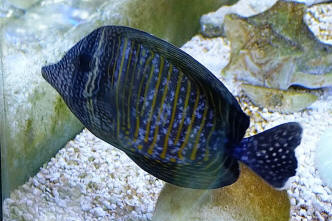 |
|
Re: Patches on Sailfin tang 3/27/19
Hi Wil,
<Bodh>
Thank you soo much.
<Most welcome>
The parameters in display tank are Ammonia 0, Nitrite 0 and Nitrate near 0.
Other tank mates
1. 2 Blue damsels small (1 inch)
2. 1 Fox face
3. 1 Cloud Angel small (1.5 inch)
4. 1 Pink Anthias small (1.5 inch)
5. 1 Banana wrasse
6. 1 Green carper anemone
7. 1 Camel shrimp
8. 2 hermit crabs
9. 1 Percula Clown
Any advise or suggestion to me ?
<As stated….and please see Bob's input in your other e-mail.>
Thanks & Regards,
<Anytime, Bodh. Wil. >
|
|
Mimic patches on face 2/7/19
Hello crew
<Hi Chris>
Attached is a photo of my latest addition; a mimic tang. I am trying to figure
out if the white irregular shapes on one side of his/her face is parasitic, or
from injury of some sort.
<I can see this in your very nice pic. It could be an injury made with a rough
surface, if it don´t heal on its own in a few days, we are probably in front of
a HLLE case at its early stages.>
The tang has been in the main display for ~ 4 weeks and the "patches" on his
face appeared about 10 days ago.
<Are you using activated carbon? sometimes its use triggers this condition>
Please ignore what looks like a sprinkling of salt over the rest of him, it is
just the debris in the water I could not avoid. He is absolutely clear outside
or 3 or so white patches which do seem to be a bit raised but not by much. There
has been no progression since I noticed it. He/She does not scratch, flare and
is eating .well. like a tang. Diet consists of Omega one flakes, Red algae
strips and occasional frozen cubes of mixed meaty foods..not to mention the
constant grazing.
<Have you try Newlife Spectrum pellets?...have give me very good results over
the years.>
His home is a 265 gallon SPS tank with a few LPS, Hammer coral and several
Duncans. Tank mates are 1 Scopas about the same size, Ocellaris clown, 1
Chromis, 6 line wrasse, bicolor blenny and a Mandarin. There is really no
aggression in the tank. The scopas and mimic will eat the strips greedily
together.
Ammonia 0 detectable,
Nitrite 0 detectable
Nitrate really undetectable using API kit
pH 8.04 to 8.13 (tank is in basement)
Temp kept at 75 using Apex controllers
ORP ~310
Salinity 1.024
<Looks like a well maintained tank.>
Any thoughts on what this could be? My other fish I had had for anywhere from
4-6 years and they are not showing any signs of illness. I would like to add to
the room mates, but I want this to "Clear" up before I do
<Watch it for the following days and keep us posted.>
Chris
<Cheers. Wil. >
|
face.jpg) |
|
White ring on Clown Tangs head 1/20/19
Hi Crew,
<Hey Lloyd!>
I was admiring my fish and noticed this ring on my clown tang that is on his
head near his left eye. I would like to know what this is. And if it is a minor
or serious condition? He is still aggressive with the other fish, eating and
swimming, no visible signs of stress. But I worry that it could get out of
control quickly. To me it looks like he may have rubbed a rock or gotten into a
small fight that has caused this.
<You´re right, it is a physical trauma, I wouldn't worry as it will heal in a
few days/weeks, just pay attention to its behaviour to see if it is scratching
against the rocks; I hope your tank is big enough (150+g).Surgeonfishes need
plenty of space to swim freely.>
Regards,
Lloyd
<Cheers. Wil>
|
 |
Purple Tang eye problem
12/14/18
Hello,
<Hello there>
I have recently found your site, I have a purple tang who looked in very
good health when I bought him. On the second day in my aquarium I notice
a singular eye did not look quite right. The issue is now 3 weeks old
and his eye appears to be in the same condition. It looks as
though air is trapped under the lens of his eye. The other eye
looks normal but the fish I would say is more reclusive and stressed
than if his eye were not suffering.
Please see my photo. Is there anything I can do for this <This is a
physical trauma caused by the fish hitting something (likely
rocks/decorations); or by some tankmate nipping at it, please see/read
the
following link and the related ones:
http://www.wetwebmedia.com/popeyetrauma.htm
Cheers. Wil. >
Re: Purple Tang eye problem 12/14/18
Hello,
Thank you for the reply, I have studied the thread you linked and from
my understanding the best course of action is likely to do nothing as it
seems most like the physical trauma to the vascular network that Bob
commented on 12/27/06 with regard to Holocentrid. Is this correct?
<Yes, as Bob stated.>
Should I dose Epsom salt and if so what is your recommended dose rate?
<Just maintain good water quality and be patient, as complete recovery
may take several weeks.>
Cheers,
Lloyd
<Cheers. Wil.>
Re: Purple Tang eye problem 12/14/18
Thanks Wil,
<Glad to help >
I´ll maintain water quality and hope for a full recovery.
<Good. Please keep us posted>
Regards,
Lloyd
<Wil.>
Re: Purple Tang eye problem 1/10/19
Hello Wetweb team,
<Hey Lloyd>
I wanted to let you know that my purple tang has made a full recovery
with hyposalinity and the use of Sea Chem Paraguard. I was very
skeptical until about day 13-15 of treatment as his condition did not
appear to be improving. Then one night lights out and the very next
morning he was better. I have continued the treatment for the
recommended length of time and will be bringing salinity back up in a
weeks time but I wanted to thank you for the advice and notify you of
the improvement.
<Glad to know everything is fine with your PT.>
Kind regards,
Lloyd Cook
<Greetings. Wil.>
|
Black Spot disease after long power outage
7/16/18
<We ask that query attachments be kept to hundreds of Kbytes; yours are 14
megs...>
Good Afternoon team, hope you are well. Sorry for this very long message.
Your input is much appreciated. Tank set up and parameters: Red sea reefer 350,
skimmer Bubble Magus Curve 5, 2 x250 watt heaters, wave maker. FOWLR system with
live rock (25kg), flame angel (1.5 inch) 2 x da Vinci clownfish (1 inch) and a
vampire tang (3 inches), 3 hermit crabs, 2 cleaner shrimp, 1 fire shrimp, 1
snail, free critters on live rock, temp usually around 24 degrees Celsius,
ammonia 0, nitrite 0, nitrate 15. Salinity went up over outage as I forgot to
add RO for about 5 days, its 1.028 today and just
brought it down to 1.026 over the course of 4 hours. Tank has been running for
about a year. Last fish added in January 2018. We are in the middle of a week
long power outage (entire substation burnt down due to a fire. I live in South
Africa and its currently winter which makes it worse in terms of keeping the
temperature correct during an outage. After power went out last Tuesday my tank
temp dropped to 18 degrees Celsius and then to 17 on Wednesday. Lights, skimmer
and pump was off for 2 days. I ran 4 bubble makers on batteries during the
outage to create water movement. I managed to connect a generator to the tank on
Thursday (day 2 .5 of outage).
Skimmer, heater, pump and lights on generator. From Thursday the temp was
increased to 19 on the first day then 21 and 23 on the second and third days
trying not to shock my fish with large changes in temp. Fish were very stressed
during power out and also first day or two after lights came on.
Snail looks a bit weird not sticking to glass and falling over, but still alive.
Moved snail to the top of wave maker, looks happy and stick to wave maker. My
tang appeared to be dead when I first switched lights on after 2.5 days, but
apparently just hiding, turned herself black and almost didn't breathe, started
to peek out from her cave after 30 minutes. Because I can only run the generator
during the day the tank then loses about 1 degree Celsius over night. (Need to
watch the generator and it might get stolen over night)
<Yikes>
At night I connect battery operated bubble makers for oxygen and water movement.
Only fed the tank on day 2.5, 2-3 hours after generator was switched on and fish
seemed to be normal and not as stressed out anymore. Im feeding as normal now
and fishes are hungry, not sure exactly how much would constitute overfeeding?
<Beyond taking foods, too fat to move...>
Would live rock filtration be stressed as well?
<Yes; with change, rate of change>
My marine tank appeared to have survived the outage without any negative effects
until this morning that I noticed black spots on my tang. Please see pic
attached, I suspect my vampire (Lieutenant) tang
has black spot disease, dull black spots over the body, a few clear black ones
as well. Also a few Transparent spots on fins, she had some of this when I got
her from the LFS but this went away after quarantine. I would appreciate if you
could share your thoughts. All other fish difficult to tell if they have it,
flame has 2 black spots on fins but this does not look like the same disease as
tang and he/she is not scratching. One of the clowns might have one spot on his
forehead. After a stress event like the power outage, I think my tang (and other
fish ) will be more stressed if I try to catch it to treat it in qt?
<Yes>
Tang swims like normal, looks very happy in display and eats a lot as usual.
Appears healthy breathing normally etc. all other fish are acting normal, my
clowns are eating a bit less than usual but their appetite is picking up over
last 2 days since I've upped the temp. I have seachem Metroplex which I added to
their food today in two feedings. Tang ate the first feeding with Metroplex but
started to spit out the second. Other fishes ate 1 - 2 flakes of this each. Not
sure if I should continue with medication or rather add this to the water, it
says it is reef safe.
<I'd hold off on further treatments for now>
I am working to correct my water parameters after realizing its not correct
today. I have performed a water change 10% and reduced salinity to 1.026. I also
read that hyposalinity could help with black spot so I am planning to keep
reducing salinity slowly to 1.020 over the next 3 days and then keep it there
for the next 6 weeks. Not sure if I should continue to raise temp? If yes to how
much would be ideal. Im concerned about amount of oxygen in high temps, perhaps
some guidance how this affects the fish and the disease/parasites? My LFS
suggested a temp of 28 degrees Celsius, but I read contrary info that this would
speed up the disease progression in the fish’s system as well. Trying to keep
the temp constant on 23 degrees Celsius now. I am currently feeding ocean
nutrition formula 2 and brine flakes, my fish loves the brine shrimp plus
flakes. I usually feed frozen food as well but all went bad with power outage.
My
cleaner shrimps are all over my tang to clean him, not sure if this helps.
He is parked in the cleaning station every 30 minutes. Only weird behaviour was
that tang started scratching himself in a different way than usual yesterday(my
tang usually scratches his side once or twice a week that I see on the gravel,
never had any spots that I could see) as from yesterday the tang flips more than
180 degrees to scratch, this afternoon scratching seems less, more cleaning
activity. I would really appreciate your input on how to Treat the potential
black spot for the tang and others if applicable. I am hoping that our
electricity is restored today at midnight as I will then have permanent heating,
skimming, pump on in the fish tank.
Kind regards,
Millezanne
<The spots may be "nothing"; simply environmental stress; could be Paravortex
(see WWM Re); but in any, all cases, doubtful this is a dangerous parasitic
situation. Do your best to maintain optimized conditions for now. Bob Fenner>
|
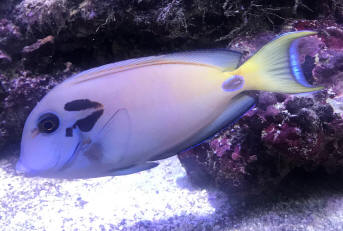 |
|
Black Spot disease after long power outage
7/16/18
Hi Rob,
<Mille>
Thank you for getting back to me so quickly!
<Welcome>
Black spots are fading fast, this morning barely visible, so your thinking it
being stress related was spot on.
<Ahh>
This morning noticed that my tang also have 3 distinct salt grain look alike
spots on fins that wasn't there last night. Looks like white spot disease.
<Again; doubtful this is pathogenic; a disease due to a biological agent>
Tang is still looking healthy and eating. Breathing is normal. Other fishes not
affected
Salinity now on 1.025 and nitrate 10. Still battling the power outage, water
temps now on 23 during the day (with generator) and drops to 21 overnight.
<No fun for all>
Would you recommend any treatment? What would you suggest at this moment?
Lowering salinity a bit? Temperature higher?
<None of the above>
Or nothing and just monitoring
the situation.
<The latter only>
Thank you & Kind Regards,
Millezanne
<Cheers, Bob Fenner>
|
|
Naso Tang with skin issue 2/23/18
Hello. I have a Naso Tang with some white scratches and areas of what appear to
be slightly raised lumps.
<I see this in your photo>
I first thought they could be from scratches from the live rock. She has a great
appetite and is behaving normally. Any insight?
Ragan Wilson
<Mmm; yes... likely a nutritional issue here; but could have trauma/physical
damage, water quality component/influences as well. This fish is too thin (has a
low index of fitness). I'd have you read on WWM re
Naso and Naso lituratus period; esp. nutrition/feeding. Do so. Bob Fenner>
|
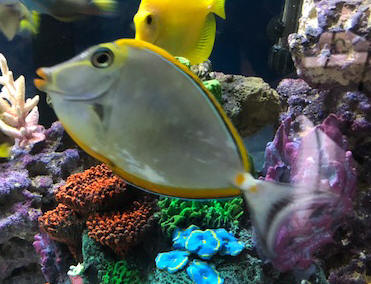 |
|
Re: Naso Tang with skin issue 2/23/18
Ok, thanks. I’ve been treating the Naso for Ick with copper and am on the third
week of treatment.
<Acanthurids and Cu don't mix. PLEASE read where you've been referred. You're
poisoning your fish>
She is eating very well but now I’m concerned that maybe the copper is affecting
her nutrition.
<Ah; you are wise here; or at least knowledgeable>
I don’t see any signs of Ick but was told to treat the parasite for 28 days. Do
you think I should stop the treatment early? Thanks again.
<Yes I would. BobF>
Ragan Wilson
Re: Naso Tang with skin issue 2/23/18
For future reference, what is your method for treating Ich?
<Haaaaa:
http://www.wetwebmedia.com/ichartmar.htm
and the linked files above. B>
Ragan Wilson
|
|
Mimic tang injuries (?) and a (possibly) nibbled Galaxea
12/29/17
Bob, et. al.
You are all amazing and I really appreciate all the excellent assistance you
give! I came home to notice what look like injuries on my mimic tang. I didn't
notice anything yesterday and I did rearrange the rockwork in the holding tank
to allow more open space for swimming/observing, so I'm wondering/hoping he
somehow got injured rather than suddenly expressing an illness.
<Possibly>
The damage is only on one side. He is 3.5" and has been housed for 3 weeks in a
70 gal holding/QT tank with a 3.5" PBT, a 4.5" Z. desjardinii, 2" flame
angelfish, neon cleaner goby, 1" Rainford's goby, and a .75" Pajama
cardinal.
<All these tangs are getting along here?>
I also noticed damage to the Galaxea coral polyp I'm using to gauge the
reliability of the angelfish...does the central polyp look "munched" to you or
maybe some other cause?
<Again; it's possible, but not likely from fish grazing. Oculinids, galaxy
corals are VERY stinging>
I just moved the coral prior to the picture so it isn't particularly happy and I
haven't ever had a coral nipper (knock on wood) so I'm not certain...
<I would not be concerned here re the fish livestock nibbling Galaxea. The Mimic
Tang will heal in time, given good nutrition and a lack of aggression. Bob
Fenner>
|
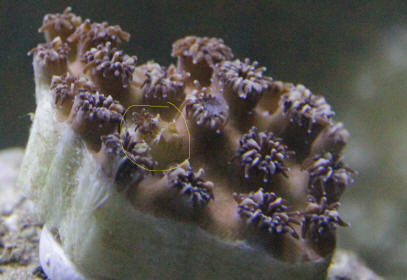
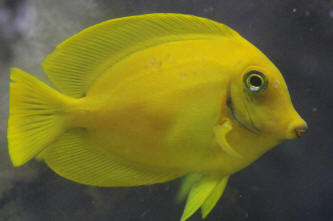
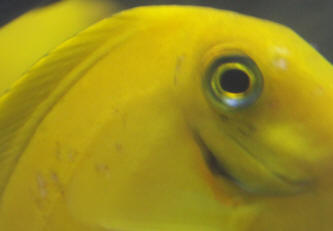 |
|
re: Mimic tang injuries (?) and a (possibly) nibbled Galaxea
12/30/17
Bob, Thanks for the quick response. The tangs haven't shown *much*
aggressive behavior, though the Desjardinii hides a lot when we're around.
<Good and not atypical>
I have lots of grazing opportunities in the tank and they're well fed. I did
notice some flashing/aggression from the PBT the day previous, which is one
more reason I suspect injury.
<Me too>
They've been in QT for three weeks without any signs of illness... Should I
move them to the 220 gal DT even though they haven't finished out QT?
<If it were me, mine... I'd move the two, but leave the PBT for another week
or two in QT>
Move the mimic to a 29 gal treatment tank to observe wounds/sores?
<I'd just place it in the main/display. Will heal on its own much faster in
a stable environment>
Put the rock work back to the way it was before the sores?
<I'd leave as is>
Any other suggestions?
<Keep beer in a cool, dark place>
Thanks a million!
Branon
<As many welcomes. BobF>
|
|
Mimic Tang issue 11/21/17
Hello,
<Hey Ron>
Looked online trying to diagnose whatever this aliment is affecting the fish in
attached picture.
It is of a friends fish. She states that the area is raised and that fish is
swimming and eating normal.
Any help would be appreciated.
Thank you in advance,
Ron Ruesch
Wisconsin Reef Society
<What is this? Looks... almost viral; or possibly resultant injury from... a
brush with a very powerful stinging organism. What other life present here? NOT
HLLE; and I would not treat this fish, system. Just good care... water quality
and nutrition. And time going by. Bob Fenner>
|
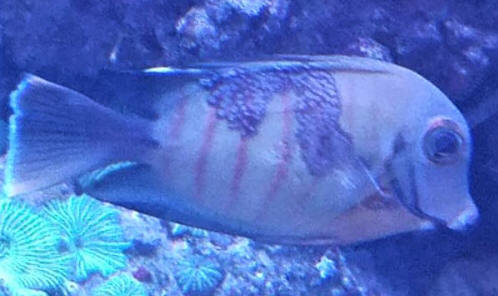 |
|
Re: Mimic Tang issue 11/21/17
Thanks for the reply Bob.
Only stinging organisms in the tank according to my friend are a torch
coral and a mini maxi anemone.
<Ahh; these might well "be it">
She is going to work on better diet and
vitamin supplement.
Hope you have a great thanksgiving,
Ron
<Thank you Ron; and you and yours. BobF>
|
New Fish (Tang) - Quarantine
11/9/17
Good afternoon Crew,
I feel your forum has a mixed bag of answers,
<... we don't have a forum>
and although I was pretty confident with my previous decision, I'm now
undecided. I've successfully treated numerous fish for crypt via
Cupramine in the past and have yet to experience a loss during that
process.
<Acanthurids don't tolerate copper exposure well>
I enjoy the comfort of knowing I have a crypt free tank.
<I doubt this is the case... Most all hobbyist systems (99 plus percent)
have resident Cryptocaryon et al. infestations>
In Sept I bought a Kole Tang that I knew had Crypt, and requested both a
guaranty on the fish and $ discount from the store because of this. The
Tang was active, alert, plump, and feeding... thus I figured he'd be a
good
candidate to QT and utilize Cupramine to get him healthy for my display.
Finished the 16 day treatment and he was still feeding and looked
vibrant and healthy, so I introduced him to my display tank. 60g with
two Picasso clowns, yellow watchman goby, royal gramma, and a rose BTA.
Everyone left
him alone and for the first few days he was somewhat shy, but still
active.
Approaching the two week mark in the display tank he remained hidden and
I can't recall seeing him eat in the display tank ever, although I
purposely left some hair algae alone for him to pick at. Roughly two
weeks, the Kole
Tang died. I know I used the proper dosage of Cupramine, and if I was
slightly off... I was likely slightly a lower dose than higher.
Previously Bob Fenner suggested that Tangs are definitely more sensitive
to copper treatments than other fish.
<Ah yes>
Maybe it was the Cupramine?
<Quite possibly a contributor>
Maybe it was something from the collection process - but then I'd
suspect perhaps this fish wouldn't have been active and feeding for the
first few weeks. Maybe he grazed my BTA, but I wonder if touching my BTA
could cause a two week decline and death in my Tang? Stumped.
<I agree w/ all your speculations>
So, in a long winded question... I'm afraid to add a new Tang directly
to my display tank. This seems like the least stressful way to introduce
a Tang, but I'm very concerned with a new Tang bringing crypt back into
my
tank.
<You are wise here>
If it was you, how would you introduce a new tang?
<Isolation, sans treatment for a few weeks, lowered spg (1.012).
Possibly CP feeding>
I do have a 20g bare bottom QT available. I hate any fish loss, and just
want to do what's best for my existing reef community as well as any new
acquisition. Thanks again!!
Dave
<Welcome. Bob Fenner>
Re: New Fish (Tang) - Quarantine 11/9/17
Thanks. So, I assume gradually lower salinity from store water to the
1.012, and then eventually up it to my tank that sits at 1.023?
<Yes>
Possibly CP Feedings?
<... Please search WWM re Chloroquine Phosphate use>
Not following you there.
Dave
<Sorry re. BobF>
Achilles Tang 10/27/17
Greetings WWM Crew!
<Hey Dan!>
I hope all is well. I have been wanting to keep a small (~4") Achilles tang in
my 5-ft. mixed reef tank. I understand I will have to move the Achilles at some
point, but I think I will be able to enjoy a small one for a couple of years.
<At least... if raised from small, a five foot long system might do for several
years>
My aquascape is open with swim throughs. Strong, non-linear flow. I have an
efficient nutrient export system where my nitrates (<5ppm) and phosphate
(<0.03ppm) are low.
<All good>
All my inhabitants are healthy and happy with an occasional spat between the
purple & yellow tangs.
<Ah, yes>
I have a lot of wrasse for pest control & aesthetic reasons: 3 leopard wrasses
(bipartitus, meleagris, and choati) ~4" each, red Coris wrasse ~7", 2 different
fairy wrasses ~ 4" each, yellow Coris ~4", melanurus wrasse ~4"
2 Zebrasomas for algae control: purple tang ~6" and yellow tang ~4"
2 cleaner shrimps
10-12 peppermint shrimps for Aiptasia control
various snails
My husbandry in terms of feeding is 4-5 different types of algae based pellets
in the morning and then LRS, Rods, & PE Mysis at night.
<Tres bien!>
My main concern is aggression with the Zebrasomas, particularly with the yellow
tang. He is just territorial with a particular cave in my reef
tank, otherwise he does not bother anyone. I can always use my acclimation
box and/or mirror on the side of the tank trick to reduce aggression, but
re-aquascaping is highly unlikely due to my corals. So, I want your
opinion if it is a good, worthwhile endeavor to try a small achilles tang?
<If the Achilles is small; as you state, about four inches overall or less,
you should see only minor "jousting" twixt it and the Zebrasomas>
Many thanks in advance.
Dan
<As many welcomes. Do please write back w/ your observations. Bob Fenner>
Re: Achilles Tang 11/1/17
Hi Bob or Crew at WWM,
<Hey Dan>
Thank you for the quick response with my last correspondence and your invitation
to report back on my quest to find an Achilles tang. As you know, the Hawaiian
legislation is making the search difficult with all my LFS. Luckily, I just
found a suitable size, 3 ½ inch Achilles at LiveAquaria.
<Ah yes, and good>
I have the following questions regarding the quarantine process:
1. I have a 15 gallon quarantine tank that has served me well in terms of
acclimating difficult to keep fishes like my leopard wrasses. What are your
thoughts in terms of a 3 ½ inch Achilles, would it be more beneficial to have a
short QT period (~ 1 week) vs. a full QT period (2+ weeks)?
<Likely somewhere either one or two weeks; only to be determined by your
observations of the fish's apparent health, stability>
The thought here is to get the Achilles in a larger, surging display tank with
stable water parameters asap.
<Yes>
My methodology is always to observe and then react based on how the fish is
behaving.
<Mine as well>
2. When it comes to treating delicate fishes with medication, I do not treat my
QT tank if the fish does not show any sign of parasite/disease. I think copper,
etc. will cause undue stress and maybe more deleterious, especially when it is
not necessary.
<Very harsh on this species. I would resort to other (albeit less effective
treatment moda: extreme drop in spg... 1.010; perhaps consecutive pH adjusted
freshwater dips/baths, and moves to re-set up system... to exclude intermediate
phases>
I may perform a preventive dip prior to transferring it to the main display
tank.
<Yes I would; as well as one on the way into quarantine from shipping>
I use Blue Life Safety Stop, it is a 2-parts dip (part 1 is formalin and part 2
is Methylene blue).
<Ah yes; am very familiar>
If the Achilles shows no sign of parasite/disease, should I even use the dip at
all?
<I would dip unless the fish is shaky from being moved>
Again, I want to minimize as much stress as possible.
<Understood>
Being in this hobby for years, I always appreciate your work & contribution to
help hobbyists like myself and further this niche, challenging, but rewarding
hobby.
Best,
Dan
<Cheers, Bob Fenner>
|
Trying to save my fish; CP f' 9/10/17
Hi
<Mike>
I had a group of 5 fish (juvenile Queen, an adult Imperator, a Powder Blue and
Achilles tangs and a smaller Blue Jaw Trigger) in my 160 gal QT system, made up
of 3 - 55gal tanks plus sump. They have been there since Aug.
12th. They seemed to be doing good at first. They were in lower salinity water
for over two weeks ~ 17ppt, temp 78F, pH around 8. I started to slowly bring the
parameters up to match my display when I saw Ick break out on the Tangs.
<Very common; as you likely know these two Tang species are VERY susceptible>
I lowered the salinity back down to 17ppt and did 2 treatments of Chloroquine
Phosphate (from National Fish Pharmaceuticals) . After a week the trigger died.
The Ick seems to have morphed into Amyloodinium
ocellatum - cloudy eyes, shedding slime, patchy white on the Achilles...I'm not
sure if the darkening pelvic fin is on the Powder Blue is a symptom of something
else.
<Could be sampled, looked at under a 'scope. Perhaps just chemical/physical
burn>
The tangs have stopped eating.
<VERY bad>
The two angels are still in better shape - I only see white spots on the eyes
and they are still eating well. I gave both tangs a fresh water dip yesterday
but didn't see any improvement. I pushed the salinity lower to 14ppt. I am about
to do a 25% water change and give another treatment of Chloroquine. Am I missing
something?
<The CP may be hurting more than helping here. >
Is there something else I should be doing? Here are some pictures.
<IF these were my fishes, I'd NOT use the quinine, but just drop the spg.
down to 1.010, and hope. They may be too impugned to come back at this point>
I would appreciate any suggestions you might have Thanks,
Mike Spizzirri
<I would have you read re others experiences w/ CP (on WWM) as well. Can be
tricky in use:
http://www.wetwebmedia.com/QuinTrbFixF.htm
and the other Quinine FAQs files linked above. Bob Fenner>
|
.jpg)
.jpg) |
|
Cloudy pop eye tang 7/8/17
Hi, thanks as always for the wonderful service you provide everyone! Your
advice, articles, and information are all super!
<Ah, good>
I have an orange shoulder tang I just got and apparently the sellers other fish
picked on it and damaged its eye.
<This beautiful species is on the end of the scale w/ a few others (Powder Blue,
Brown...) in terms of being hard to keep in captivity. REALLY needs a BUNCH of
room (hundreds of gallons)... VERY clean water...>
I attached a picture of the eye. It is in a 100 gallon stock tub QT now.
Should I treat the fish with something or just rely on good water quality and
food to help it get better?
<A tough question... as the bulging eye is unilateral/one side; this is highly
likely a case of trauma (rather than bacteria, parasitic...) issue>
If I should treat it what should I use? Does it look like it will be okay
eventually? Thank you!
<Let's have you read here re:
http://www.wetwebmedia.com/Popeyecures.htm
and the linked files above as much as you'd like; to gain perspective.
Unfortunately the prognosis for this species, kind of injury is poor. Bob
Fenner>
|
 |
|
Re: Cloudy pop eye tang 7/8/17
Hi Bob, thanks for the incredibly timely response. I read the FAQ's before
emailing, but didn't see a definitive answer, but after evaluating it more I
think what I'll do it wait and see.
<Ahh, yes. This is what I would do. This IS a fave species of Tang, esp. when
out diving in Hawaii, am always looking for its broad flanks scooting about the
bottom, feeding>
The fish came from someone's established tank and went to another reef keeper
whose fish picked on it, and then I got it so it is not brand new to a tank.
This evening I think the orange shoulder tang is looking a bit better. He is
eating Spectrum pellet food like a pig and picking on nori.
<Good food choices>
His eye looks close to the same. I'll just keep him in the 100 gallon QT tub for
a while and keep the water clean, it has a decent skimmer too. After that if he
is okay in 3-4 weeks he can go in my 300 gallon tank which has 500 gallons of
total volume going through it. Hopefully that'll be big enough. By the way, you
spoke at our reef meeting in San Diego and I saw you speak at the last MACNA on
butterfly fish, which I was contemplating getting but decided not to after
learning more about them. ��
<Ahh! Am hoping that Mark Lawson will help resurrect the San Diego Club. Have
offered to help in what ways I can/may... Giving programs, lining up others,
manufacturers, distributors for donations et al. Hope to see you at the upcoming
(August) MACNA in LA. Bob Fenner>
|
|
8 year old Shoulder Tang
1/27/17
Aloha,
<Howsit? Darrel, you owe me some part of twenty US... your too large file
wouldn't load here in Fiji. Had to sign up for the advanced svc. Hundreds of
Kbytes mate, NOT megs>
I really appreciate the service wet web media provides. Mahalo. To Bob
Fenner and the crew.
<Follow our guidelines then!>
I operate a Marine aquarium maintenance service and recently some thing
happened to an 8 year old shoulder Tang that I haven't seen before.
The Tang resides in a 650 gallon Fish only aquarium 8.2pH 40ppmNitr 1.021SG.
<A bit low>
About 3 weeks ago, a golden head goby I added died fairly quickly.. 2 weeks
or so after 15 days QT time. A little while after the Tang developed brown
splotches and started to hide.
<Mmm; likely not related>
With parameters in line, I immediately suspected parasites of some kind.
Close inspection of some of the other larger fish, 2 yellows, 3 Blue Hippos,
and a 10 year old Stars and Stripes puffer, revealed little.
Nothing evident on the fins, clear active eyes, no scratching, etc.
However the fish mostly clustered in one area of the reef insert for about a
week.
<Mmm; environmental. Something/s you don't measure are off>
There is also an 8 year old Heniochus that is mostly hiding but has no
visible discolorations.
Any advice?
<When, where in doubt, punt! Massive water change (like half), with gravel
vacuuming, addition of a few units of ChemiPure and PolyFilter in the flow
path. Bob Fenner>
Thanks in advance.
|
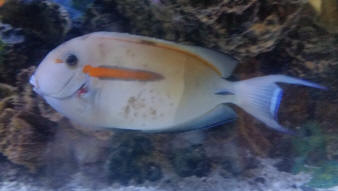 |
|
Re: 8 year old Shoulder Tang
1/27/17
Oh, the system also is running a 120 watt Emperor Aquatics Smart UV (40wx3)
6 months of service for the current bulbs.
<I'd be checking the Fe +2 and 3 coming off the igneous. B>
Darrel
Re: shoulder tang 1/27/17
Mahalo. I will send you a check or money order. U.S. funds?
<Heeeee! Thank you for the offer Darrel>
I already did everything you suggested prior to contacting you.. the
markings improved and then came back albeit in a different pattern. I will
repeat process.
Thanks again.
<This Acanthurus (does) suffer/s from many types of environmental (over)
stress. IF it's still eating, moving about... I give you good odds of it
recovering. A hu'i hou! Bob Fenner>
|
|
Purple Tang! Is in my eyes, lately things don't seem the same...
7/6/16
I have an older purple tang in my well established reef tank who has
recently developed some type of disease for which I cannot find a matching
picture.
<Mmm; actually the pitting, some body whiting is very common; with
Surgeonfishes near the top in terms of susceptibility. Variously called
HLLE.... acronyms... Due to...? Poor nutrition, aspects of water quality...
some folks even believe (not I) stray voltage. Read here Re:
http://www.wetwebmedia.com/hlle.htm
The linked files at top>
He eats, swims normally and this began about one month ago with what looked
like vertical scratches on his back half. He has had what I presume to be
lateral line disease for a much longer time. These vertical "scratches" are
new. no other fish affected.
any thoughts on what this might be and how to treat it?
<The same... improve the environment; particularly ORP/RedOx, supplement
nutrition w/ soaking foods in HUFAs, Vitamins... consider adding a refugium
w/ DSB, macroalgae culture on a RDP lighting regimen.... and "mud". These
effects can be reversed... as long as the scarring isn't too deep. Bob
Fenner>
jay spector
|
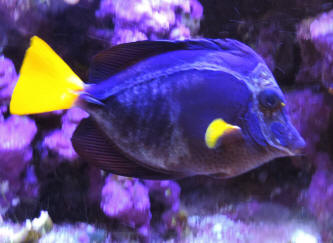 |
Purple Tang - Ich - Cupramine
6/9/16
I have a dilemma and would appreciate your great advice as always.
<What's up?>
Note that I have a permanent running and fully established 75 gallon
QT/Hospital tank.
<Good>
About 4 weeks ago I purchased a Purple Tang (maybe 5 inches in size).
<What did Gurley Halleck expound when seeing his first worm in "Dune"?
"Egads, what a monster"! This is a big Zebrasoma to purchase, collect
from the wild>
I purchased it from a reputable LFS. It was eating like a pig, was
active, and showed no signs of illness. They stated that it had been in
their possession for a few weeks.
<I see>
As I do all new fish arrivals, I put it into my QT/Hospital tank for
close to two weeks.
<Mmm; no dip/bath enroute? I would do so... to "knock off" Protozoans,
Trematodes... external issues>
It was fine, eating like a pig, no issues, no illness. Thus, I moved it
to my 150 gallon DT. This tank has been disease free and all the
readings are very good. I believe in "over-filtration", thus there's
plenty of flow, a UV filter, oversized skimmer, oversized sump pump,
refugium (with Macroalgae, red mangroves..), and about 100+ pounds of
live rock...etc. I have high powered LED's on the tank. There's been no
issues of aggression within the tank and the Purple Tang would be
hypothetically considered the most aggressive type of fish in that tank
and the currently largest fish
for that tank, excluding a well fed 10 inch Snowflake Eel that minds his
own business and who's been a good citizen.
<Echidna spp. usually are>
Other inhabitants are a 3 inch Flame Angel, a 3 inch Koran Angel, a 4
inch Majestic Rabbitfish, and a 3 inch Sailfin Tang.
<Okay>
I knew that I was "rolling the dice" with the Sailfin Tang already being
in there, but after a lot of reading and visiting with LFS' I was fairly
confident it would work as I've previously introduced a Sailfin Tang
into a different 150 gallon tank with an established Yellow Tang that
has worked out well thus far and for over a year. IMO, from research and
experience, it seems like the Sailfin Tang's are more likely to co-exist
of the Zebra species if introduced at a different time.
<This is my and many others (recorded) experience as well>
After a little bit of posturing back and forth maybe for 2 days, the
Purple Tang and the Sailfin Tang adjusted and accepted each other. I
never witnessed any chasing or nipping, simply a bit of posturing,
flaring up of the fins. The Purple Tang continues to eat well. However,
within the last week the Purple Tang has developed Ich. None of
the other fish display any signs of Ich.
<Common and not uncommon>
The Purple Tang continues to eat like a pig, swims all over the place,
and seems very healthy, very happy, except for the Ich, always very
eager to eat, getting excited when I approach the tank. I feed him and
the tank a mix of mysis shrimp, brine/Spirulina, and algae sheets.
Since he developed Ich I've been adding Selco, VitaChem, and Metroplex
mixed with Garlic into the food this tank eats. All of the fish eagerly
eat at each feeding which is 3 to 4x a day. Usually I feed 2x a day, but
I stepped up feedings to hopefully strengthen their immune systems.
Here's my dilemma, I could move the Purple Tang to my QT/Hospital tank,
which seems like a no brainer, and for most any other fish I would do it
ASAP, but this Purple Tang, despite its case of Ich is a very happy fish
that's very active and eats like a pig. I am concerned about stressing
it out, trying to catch it, then move it to a new tank. Might this put
it
into a downward spiral?
<It could; yes>
I've always successfully used 1/2 the recommended dosage of Cupramine to
treat Ich. Keeping the fish in QT for 4 weeks. I just ordered some
Dr.G's Caviar that includes CP too that I intend to feed this 150 gallon
DT with the Purple Tang. I've done some research on Purple Tang's and
Cupramine and it appears that they might have more sensitivity than most
other fish to Cupramine?
<Tangs and allies... and a few other fish families/groups too... You can
search, read this on WWM, in books I've penned>
Thus, this too, makes me think I should continue to treat the DT with
medicated food. However, am I doing the right thing? Would you move the
Purple Tang to the QT? Thank you.
<I would NOT move the Tang... but leave in place, continue w/
the feeding treatments you're doing and have planned. Some
archived input on the subject here:
http://www.wetwebmedia.com/parasittksfaqs.htm
and the linked files above. Bob Fenner>
Fw: Purple Tang - Ich - Cupramine
6/9/16
I forgot to mention that this 150 gallon DT with the Purple Tang is a
reef tank, thus my use of treatment so far by medicated food.
<Ahh; please read here as well:
http://www.wetwebmedia.com/reefparasittksfaqs.htm
and the linked.... B>
Re: Purple Tang - Ich - Cupramine 6/10/16
Thanks Bob. I very much appreciate your expertise. I really needed
someone of your caliber of experience to review my dilemma and give
their opinion.
<Glad to share, render it>
My gut has been to keep the Purple Tang in the DT considering it behaves
very healthy, eats like a pig, seems really well adjusted, except for
the Ich, but I've been torn, knowing that I have an established QT.
Thanks again!
<Welcome>
BTW, note that on my QT/Hospital tank, for all new arrivals, unless I am
aware of any sensitivity to Cupramine, I dose the QT tank with 1/4 to
1/2 the recommended dosage of Cupramine for two weeks as my method to
treat for any diseases before introducing them into the DT.
<Mmm; well; the standard spiel re treatments, moda am sure you're
familiar w/; and Cu++ exposure period... does more harm than good
beneath some threshold "physiological" dose... likely near/below 0.15
ppm you're poisoning the fish hosts more than accomplishing any positive
effects>
This strategy has worked really well for me on new introductions thus
far except for this Purple Tang. I have ParaGuard, PraziPro, and Ich
Attack available in my arsenal to use too that I had tried in my earlier
reef/fish
keeping days for new arrivals, however, from experience, I've had by far
the most success with Cupramine at a reduced dosage thus I've stuck with
it for new arrivals. Beyond this, my strategy for any new coral arrivals
is to use ReefDip for 30 minutes.
<Ah, good. I've used and caused to purchase hundreds of carboys of
Cupramine. Am a fan as well. Cheers, BobF>
Re: Purple Tang - Ich - Cupramine 6/10/16
A worthy summation re Cu use in aquatics:
http://edis.ifas.ufl.edu/fa165
B
Re: Purple Tang - Ich - Cupramine
6/11/16
Bob-
I thought I would report back to you the status of my Purple Tang based
upon our mutually agreed decision to keep him in the DT vs. stressing
him out and moving him out of the DT. I am very pleased to report that
after about a week of the medicated food treatment I described below,
around 90% of the Ich spots are gone and he now has just a few spots,
while none of the other fish have displayed any Ich.
<Ah, good>
I believe our strategy of keeping him in the DT with the
medicated food cocktail with extra feedings has made a difference.
<Yes; a matter of balance. Shades of John Venn! Have you recently read
this?:
http://www.wetwebmedia.com/fwsubwebindex/fwdis3setsfactors.htm
If he had shown any signs of being passive, hiding, or as you've said in
past posts to others, i.e.; a party in the corner with himself I
believe, I would have definitely moved him to the QT and administered
Cupramine.
However, despite the Ich, as he was very active swimming, looked strong,
was eating like a pig, not hiding at all, the decision to keep him in
the DT with this treatment method appears to be working well. Quite
pleased.........
<Again; the reading... and understanding. Most all systems are
subclinically infested... READ. B>
|
Sick Tang question; env., likely Cu++ poisoning
12/14/15
Good day crew Brian here with a question... At our shop we have been
plagued with certain tang species coming down with this sickness. It
affects Tomini, Kole and Blue eye tangs only... All other fish present
normal with no symptoms.
<Acanthurids are far more susceptible; on some sort of sliding scale, than most
other fish families.... to environmental troubles, common pathogenic diseases>
It appears to only take place in one of our systems however that system
is regularly treated with formalin and occasional copper as it is our
new arrival quarantine system which is 325 gallons.
<.... environment then likely>
We have been attempting to identify the disease utilizing various books however
we have been unable to.
<.... need to sample, use a 'scope. See WWM Re>
The tangs color fades, they being to shake, dart around, stop eating, develop
dark circles, they do not scratch, no increase in respiratory rate.
<Env.>
What are your thoughts as we have tried copper,
<...? READ here:
http://www.wetwebmedia.com/crypttangsf2.htm
and the linked files above... till you become aware>
Flagyl, formalin, fresh water dips, medicated foods. Again this only happens to
these three species of tang. All others are unaffected and healthy. The other
species includes over a dozen other tangs, Angels, wrasses, butterflies,
snapper, grouper, lions ( sorry for the non specific species list but it would
massive).
Thanks again
Brian
<When in doubt, search on WWM and read. Bob Fenner>
|
 Poisoned
Poisoned |
|
Sick Scopas 7/8/15
<Eight megs of pix? Why?>
I am after some advice about my tang. Other than the signs in the photo he is
eating, swimming normally and holding his fins out.
<Ah, good>
He is in a quarantine tank and the water quality is good. Please help me
understand what may be wrong. I really appreciate your time.
Thank you
Marc
<Search on WWM re Tang Trauma... READ the FAQs files there. This fish
has been stung, burnt, physically traumatized. Bob Fenner>
|
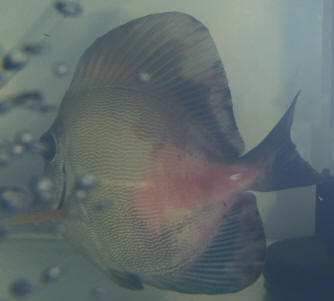 |
|
RE: Sick Scopas 7/9/15
Firstly let me apologise about the size of the photos. I had actually cropped
them and then downsized them but unfortunately in my haste to get the email off
to you I selected the wrong images (the original ones).
<Heeee!>
I will be more careful in the future. I had looked at the FAQ’s regarding tang
trauma but as the fish has only shown the signs whilst in the quarantine tank
I didn’t think that trauma was as likely.
<.... what other fishes, invertebrates present here? Any other animals with
marks? What re water quality tests? Where are the data?>
The patches of red are also visible on both sides. The tank is bare with no
rocks and only the pvc for the overflow (which can be seen in one of my
pictures). I had thought that maybe the redness and fin transparency were signs
of potential bacterial infection.
<Are other animals so effected?>
I will undertake a series of larger water changes
<Ahh; always a good idea>
and then see how the tang goes. I was considering treating with Kanamycin or
something similar if the symptoms persisted.
<No>
Thank you again for your time.
Marc
<Welcome. BobF>
RE: Sick Scopas 7/9/15
The scopas is in quarantine with a powder blue tang. They have not shown
any aggression towards each other.
<That you've observed>
There are no other fish. The blue tang shows no signs of fin damage or redness.
<The winner perhaps>
He probably doesn’t quite have the colour I would expect but considering he is
in QT it isn’t the most natural place and the lighting is very low. The only
thing with the powder blue tang is every so often he seems to bump into
something like the glass or the pvc overflow pipe (blindness??).
<Maybe; perhaps not.... could just be that A. leucosternon lives in large
spaces>
He isn’t eating as much as I would expect but he is picking at Nori that I put
into the tank. Both fish are just at the back end of hyposalinity
process.
<For? See WWM re; rarely provides permanent cure for anything... and this alone
might be an important contributor to the loss of scales in the Scopas>
It has been run at 1.009 with the pH kept at 8.0 - 8.1. The free ammonia is 0
and the nitrates are running at around 10 - 20 parts.
<Good>
The fish are due to come out of their hypo this week (4 week period). I had
planned to begin lifting salinity slowly over the next week. I have proactively
treated many fish with hypo and have never seen any adverse effects including on
numerous yellow tangs. I am somewhat stressed as I have not lost any fish to
disease now for some years (hopefully due to my process of QT, good water
quality and good nutrition). I have always found the tangs I keep to be very
hardy. I am hoping that will be the case with this fish.
<Me too>
The powder blue tang has been in captivity for approximately 5 years and the
scopas approximately 3 years.
<I would hasten them through the hyposalinity trtmt... Start raising the spg
now>
Thank you for your continued interest in my situation. I will hold off on
treatment with medication. All water changes were to use salinity and ph.
matched water.
Marc
<Thank you for this further info./input. B>
|
|
Tang issue; dis. and ID 7/1/15
Hello there,
<Josh>
If you would be so kind to point me in the right direction, I would be thankful.
I had this tang for about 3 weeks in quarantine and after I checked it for the
all clear I put it into my system. About a week later it developed these
blotches all over its body and the next day 2 of my other fish got them too.
<Mmm; best guess these are simply "stress markings" (though could be Flukes; see
WWM re).... will go of their own accord; and likely in just a few days; once all
become familiar w/ each other>
I have since put the three fish back into quarantine.
<I would put all (back) in the main-display. More stable, optimized conditions>
Could you help identify what this is?
<Appears to be a juvenile Acanthurus nigroris. Bob Fenner>
|
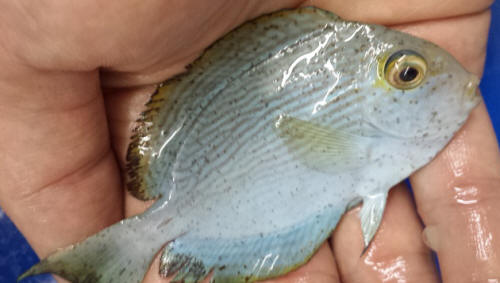 |
|
Desjardini Tang with black spots
6/20/15
Hello there,
<Gary>
I had this tang for about 3 weeks now. I had quarantined him for 14 days
then moved him into a holding tank for 7 days before introducing him to the main
system.
<I see>
He's developed this dark black spots overnight and I'm not sure what they are. I
read on your site that it could be stress marks? It doesn't look like
black ich. Do you think that's its just stress?
<I do think this is as you state; not pathogenic, like Trematodes... Good care
and time going by will see these spots go.
Bob Fenner>
|
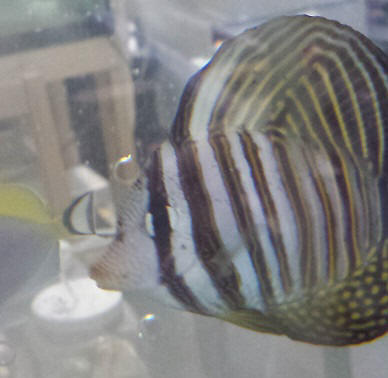
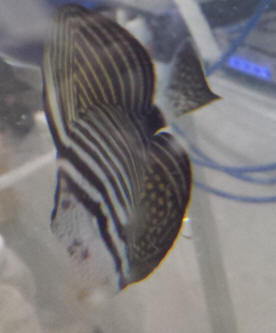 |
New Tang Trtmt. 6/4/15
Hello Bob,
<Bobby>
I have incoming tonight 3 small tangs from a local wholesaler.
I would like to quarantine for the first time, but being these aren't exactly
gobies or. clownfish I have a decision to make.
<Okay>
I have a spare 29 gallon tank, equipped with hob power filter, 600 gph power
head, and heater. I took media components, such as filter floss, sponge, and PVC
pipe that's been sitting in my fish on only tank sump for biological bacteria
for a few weeks
I can set tank up, input some media that could be my biological filtration.
Or I can skip bio filter, and do the tank transfer method every 48/ hours, not
letting ammonia build up.
<I'd use the media.>
Since they are ultimately going into my display tank at the end of it( which I
believe to be parasite free) I can use water from display tank, which also
allows me to do 20 percent water changes on my display every 2/days, instead of
just making new water only to go down the drain two days later.
<You may well have to check the water twice daily and change a good deal of it
out daily>
I have the 29, I can transfer fish, into say an equivalent size rubber maid,
bleach and rinse 29, and switch back to 29 in 48/ hours.
I know that's a lot of work but that's what I have the means to do. The other
option is cycle the 29, and run copper, but I have a feeling a 29 with no live
rock or sand may not biologically hold the ammonia output.
<Agreed>
Any suggestions for my case would be appreciated. Thanks
<I'd read on WWM re Tang Diseases... and summarily dip/bath them enroute (after
acclimating); in a pH adjusted freshwater bath... per the S.O.P. posted on WWM.
Bob Fenner>
Re: Tang trtmt. 6/5/15
Hey Bob,
Read the pH temp adjusted baths, will definitely that do that in between
transfers.
<Real good>
There will be 4 transfers, 3 days apart. I will probably wait for the 2nd and
4th session to use Prazi pro for flukes, worms etc.
<Okay... though the dip/bath should remove most all the external... look closely
at the dip water... give it a stir...>
Goal would be try to get them to eat before adding any medication.
<A bit of triage evaluation is useful: IF the specimens are in apparently good
health, treating them from the get-go is the route to go. Often in captivity,
just in from the wild, being moved... they just worsen in isolation>
I see various answers about sanitizing. What's the most recent verdict or
methodology, 1 part bleach to 10/parts water for a few hours, rinse, rinse and
air dry at least 24 hours?
<Fine>
And in theory with tank transfer, since ich can be water borne and fish carry
water in them, can they hypothetically carry ich in there bodies during a
transfer?
<Not in... or at least we should define our terms; but "on", though at times
deep-embedded in the tissue around and under scale insertions>
Or is that simply over thinking the process?
Thank you, Bob
<Welcome. B>
|
Blotchy Skin on Tangs... and comm. QT sys. design
1/23/15
Hi crew,
I've got a fish setup around 1200 gallons with 35 to 75 gallon holding
tanks. I have something that I think is spreading around on my tangs but
doesn't look like a communicable disease I only suspect it is because
its affecting 4 or 5 different specimens. I attached a picture and so
far its affected Kole tangs, chevron tangs, powder blue tangs, and a
sohal. Some of these like the chevron tangs I've had in the shop maybe 6
months.
Others like the powder blue only a few weeks. Behaviorally they seem
normal for the most part, maybe a little jittery but it's hard to say.
I've scoured the web and haven't found much so I was hoping you might
have an idea.
<Yes; this sort of manifestation is almost always "environmentally
driven"... Tangs are sensitive; and these you've had for too long a
while for this to be infectious or parasitic in nature>
I have done a couple bursts of lanthanum chloride
<Ahh; yes; this might do it. You're trying to limit soluble phosphate...
are there Cnidarians in this recirculated system?>
in the system which I've heard rumors may affect tangs but that's just a
possible theory and I don't see any real timing correlation between the
two. They get fed primarily NLS pellet, frozen mysis, and OmegaSea Nori
sheets. Nothing notable wrong with water quality.
<... that you can test for>
The system gets a 50g water change once a week. Everything is bare
bottom so ph tends to be low but we keep it buffered and it runs
generally 7.9. I've tried 1 hour formalin baths with no
noticeable improvements.
<You won't. As stated, the trouble here is not pathogenic>
One other question. I'm planning a quarantine setup and I've got like a
2'x12' space against a wall to accomplish this.
<Mmm; not for treating these fishes I take it. I would improve the
environment, leave all in place>
Do you have any references for designs I could use as a foundation?
<Ah yes; archived on WWM>
It seems in designing this there are a lot of things I could really
regret and hoping to draw on the experiences of others to have a good
system that will work for acclimation, new arrival holding, and specimen
treatment, while of course being incredibly easy to maintain =)
<Ah yes>
I've browsed around the web and found a few things but nothing that
looked very thoroughly explained or thought out. Thanks as always for
the time and advice,
Matt Johnson
<I'd skip the Lanthanum use; apply a few units of Chemi-Pure, possibly a
couple pads of PolyFilter in your filter flow path and call it a day.
Bob Fenner>
Re: Blotchy Skin on Tangs 1/23/15
Thanks for quick reply and the plan sounds easy which is always nice.
Re: QT schematics not finding any, searched "multibank quarantine",
"Quarantine plumbing", "Quarantine System Design" "Holding systems" all
not getting me where I'm looking to go. Maybe I'll just ask a couple
questions:
First, intentions for this is more of a holding system for new arrivals
vs. a hospital treatment tank. Here's my basic vision tell me if you see
any immediate flaws. Rows of 10g tanks on a shelf all with a valved line
in and gravity feed line out to a common sump with maybe some good old
fashioned bio balls. Lit by the room.
<Install an alternate "red lamp" fluorescent system... Fine for you to
see, and MUCH more calming for incoming livestock>
I could run a line from my main fish system to make water changes happen
at the same time using the main system water as the new water for the
QT.
<Good>
Buffer the water with SeaChem powders. Keep fish in here for a couple
weeks and rotate them out when new orders arrive. Any quick
recommendations on that abbreviated plan?
Matt
<What for recirculation for this system? I'd incorporate serious UV and
as small a particulate size mechanical filtration as maintenance will allow.
Bob Fenner> |
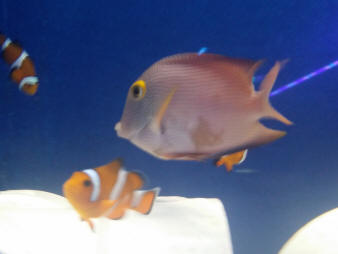 |
Zebrasoma Flavescens in quarantine 6/11/14
Hello again Mr. F.
<Mr. A>
A quick question: I have 2 Zebrasoma flavescens in quarantine for well
over 2 weeks now and they looked very good since day one, absolutely no
white spots on them, are eating very good , they actually got fat , I fed them a
lot and they have live rock covered with algae in there and they always graze
around. There is no flashing, but the only problem is that from the beginning
they seem to breath very rapidly. At first I thought they were scared
<A week is more than long enough with most all Surgeons; esp. Zebrasoma spp....
And yes to being stressed in quarantine settings; much more to be lost in
delaying... move them>
and adapting but they still do it, even if they come and eat while I am there so
they are no longer afraid.
I know ( too well unfortunately ) that this could be a sign of Cryptocaryon or
even worse Amyloodinium but is the only sign and as I told they are eating and
grazing all day.
<Highly doubtful>
When could I introduce them to the DT? Do you think there is reason to worry?
Anyway I always dip in freshwater and blue Methylene before introduction to the
DT, but I have in there very valuable and sensitive fishes and I don`t know what
to do.
Thank you,
Andrei from Romania
<I would move these and all fishes through the proscribed pH adjusted freshwater
bath (likely w/ formalin) enroute... and do this NOW. Bob Fenner>
Blindness in freckle tang
4/1/14
Hi everyone,
<Marc>
Hope all is well. I have found myself in a somewhat stressful position
and looking for some advice on the best way forward. I have a freckle
tang that I have had in QT for the past 4 weeks
<Mmm, well; this, a fave Acanthurus sp., decidedly does not like (gets
easily stressed by) small space confinement>
and he has been eating and looking great (I love these fish). However a
week ago he displayed the signs of significant swim bladder issues and I
treated with antibiotics (I was concerned it may be biological and he
didn't look happy - I understand it may have also just been a gut
blockage)
and I am pleased to say he is now swimming upright. The problem is and I
blame myself for not picking it up early enough during his issues with
his swim bladder he scraped his eyes quite badly and I fear he may have
physically blinded himself by damaging the surface of his eyes. He does
not appear to be able to see right now and I was wondering do I continue
to persist with him and see if he improves or is it more humane to
euthanize.
<I'd hold off on the latter for now>
It has been a week since he began swimming properly and I have made sure
water qualities are spot on and stable.
Thanks from a disappointed fish lover.
Marc
<Acanthuroids have remarkable powers of regeneration. Bob Fenner>
Tangs and Skin Troubles
1/26/14
After 17 years in the hobby I am for the first time ever using a
quarantine tank before adding animals to my newest tank build. I have
had a 2.5 inch regal tang
<Wow; small... >
and a 3.5 inch achilles tang in a 65 gallon QT for 2 weeks. The tank was
fully cycled and has plenty of hiding places/toys (all parameters
perfect for QT). They were healthy in all appearance upon arrival, but
after a week the regal began to show white spots ( can't say it was any
Ich I am familiar with but who knows and no pictures as they won't hold
still long enough for cell phone) on and around his head. Also along his
body on both sides appeared to be tiny bumps under the skin.
<Have to sample; look under a 'scope...>
There are minimal attempts at scratching. None of what I'm seeing is
anything I've experienced through these many years. I've never
experienced marine velvet, but there are no rapid breathing symptoms,
evenly speckled dust, or any goldish hue. This didn't help me feel good
about my decision to QT instead if ye ole tried and true natural rock
and cleaners, but now I am in it, I have to move forward along
this path. I decided to use Cupramine (in spite of the fact that I had
an achilles in there that appeared perfect) to see if whatever "it" was
would shed in a couple of days. The skin bumps disappeared, but whitish
"stuff" looking like tiny pieces of white skin (best description), again
both sides of the fish body.
Yesterday was one week into copper treatment, 4 days at the recommended
dose, both fish were still playing, swimming, and eating normally. The
achilles began to show a little tuft of white on his forehead. Today the
achilles has the tiny bumps under his skin on both sides of his body.
So... I'm going to venture a guess here and say that within the next
couple of days the bumps will disappear and whitish "skin" pieces will
appear on both sides of this fish also. Again there is minimal
scratching. Before the achilles showed signs, I was about to ditch the
copper regime and start an antibiotic. I am wondering if you've heard of
such symptoms and whether you suggest continuing with the Cupramine or
moving on to an antibiotic? Again these fish are enjoying life,
swimming, playing, and eating with minimal scratching.
Thank you so much for your time honored research and assistance, Kim
Monroe
<... I'd be reading re the use of Quinine compounds now-a-years
rather than Copper. Antibiotic/s? For what? Of no use here. Bob Fenner>
|
HLLE advice
1/14/14
I have had this scopes tang in hypo at 1.008 for the past six weeks.
<For what purpose/s? Am not a fan... have you read on WWM re Hyposalinity?>
He has been eating well and the water quality has been pretty stable. I have
tried to feed him Nori but he hasn't been that keen on it.
<... the treatment>
I have noticed a small growth on his snout and what I believe is evidence
of HLLE. Could you please confirm.
<Some apparent; again; due to the stress of isolation, exposure to low salt
concentration>
I will begin with Selcon and I am also slowly lifting the salinity back to
normal with fresh salt water.
<Good steps in the right direction>
Cheers
Marc
<Read here:
http://wetwebmedia.com/HLLESWCure.htm
and the linked files above; as well as our bits on hypo. Bob Fenner>
|
.jpeg) .jpeg) |
|
Weird Skin Disease? Env. likely 9/21/13
Good day everyone,
<Hey Lyndon>
Appreciate it if someone could advise what this could be and possible
treatment?
<Sure>
Weird discolouration that I haven't come across on a tang so far.
Thanks for the assistance.
Lyndon
<Have seen such "markings" on Surgeonfishes many times. This is highly
likely not anything pathogenic (i.e. caused by a biological agent), but
a reaction to something "too much" (or possibly too little) in the water
here. If it were my fish, and I had another established system, I'd move
it there. If I didn't, I'd look into water quality such as we have tests
for, and add a few to several pounds of healthy live rock to the
existing system... To modify the water, offer other foods.
Bob Fenner>
|
.jpg)
.jpg) |
The Stubborn Tang; not fdg. post Cu exposure
7/4/12
Hello crew! i have an interesting predicament, so I'm hoping you
will be able to help!
<Me too>
Here's the story: i have a 5'' yellow tang in my 90g DT (150g
total system)
tank, and he wont eat for me recently. I've had him since February
this year, and until about 2 weeks ago, he's been acting....off.
When i first got him he had some mild HLLE which with lots of seaweeds,
soaked in Selcon and Mysis and formula 2, he had a great recovery,
almost complete turn around of the HLLE. About 3 months ago the
tank was hit with Ich, and then promptly treated by moving all fish to a
QT and followed with copper treatment and a fallow tank for 7 weeks.
<The Cu exposure will very commonly affect tangs as you describe... make
them anosmotic, and worse, kill off necessary intestinal fauna... Need
to replenish... By adding a Tang species that does have such in its gut.
Or moving the Yellow Tang into a system w/ such "critters" living there>
After full recoveries and such.
all fish were returned and everything has been fine up until now.
I noticed the tang acting more lethargic than normal at lights on for a
few days to start, and him bumping into the rock work occasionally, so i
was worried his eyes were possibly blinded by the lights for some
reason, so i lowed the lighting levels and that didn't change it.
then a few days later i noticed faint red mark, mostly around his tail
and dorsal fin- at this point he was eating, but not as vigorously.
a few days later he stopped eating completely and as almost completely
receded into the cave network in my rocks. there was a period of about 5
days, a week ago that he seemed to have some problems staying upright
while not swimming, turning completely on 90 degrees on his 'side' and
once and a while to nearly 120 and then quickly righting him self - this
symptom has gone away recently.
now, almost 2 weeks since seeing him last eat, his HLLE is back with
almost full force, if not worse, and i cannot get him to eat anything,
even doused in garlic / Selcon. Im quite worried.
<You should be>
Param.s: 0amm/nitrite, 5-10 nitrate, 80 F, .028 salinity (a little high,
evaporation is...being difficult, slowly lowering to .026)
<1. >
I would remove him to QT but I'm afraid moving him may do more harm then
good, and all the other tankmates are looking fine and dandy ( 3'' hippo
Tang, 3 teal Chromis, 1 blue damsel, 1 fire-fish, 2 peppermint shrimp,
and a serpent-star).
Any and all help would be greatly appreciated.
<Mmm, like Rabbits (lagomorphs), Termites... and many other examples,
Acanthuroids have live G.I. symbionts... that are too-easily killed off
w/ copper exposure... You need to put the fish in a situation where they
can become reinoculated... The Tang will "pick up" these from the
substrate.
Bob Fenner>
Re: The Stubborn Tang 7/4/2012
Hey Bob, just a quick follow up with your last email.
<Welcome>
What do you suggest I do? Should I add another herbivorous tang to
the system to uh... 'Reintroduce' these critters or should I attempt the
daunting task of finding someone that can house him for a few weeks to
get him going again. (Pickings are slim in my area, my best bet would be
this one LFS near me- well kept larger tanks-, but the owner is a bit of
a hermit...).
<Yes; one or t'other>
Thanks with all the help,
Jake
<Certainly welcome. BobF>
Stubborn yellow tang follow-up 7/5/2012
Hey Bob, sorry to bother you...again, this is the last question I'm
sure:
<Not a bother>
What species of tang do you think would be a good choice for the job at
hand.
<Mmm. Do read here:
http://www.wetwebmedia.com/FishInd3.htm
scroll down to the section on Tang Selection/Stocking>
The reason I ask is, I would assume in a best case scenario another
yellow tang would be the best for replenishing these 'critters' but I
don't want a turf war in my tank by adding a second yellow.
Any thoughts? Also, would adding water from a system with
herbivorous tangs be sufficient to reintroduce the needed critters?
<Ohh, now I recall... yes to adding not water, but mulm... fecal
material... you can gravel vacuum from the one tank, place in the needed
one>
Thanks a million,
Jake
<As many welcomes. BobF>
Dussumieri Tang Lip 4/22/12
Good afternoon.
<And you Nate>
Yesterday I bought 6 inch or so Dussumieri Tang. Today I noticed his
upper lip is kind of pull back a bit, exposing his entire front teeth,
tooth, beak, whatever you would call it. I would guess it was from
banging into tank walls or rocks before I got it.
<Agreed>
Is this something I need to worry about? Also do you think this is an
issue that will fix itself on its own or will he have this problem
forever?
<Mmm, not to worry much, nor "do" anything extraordinary. These fishes
(Acanthuroids) are quite good healers given good water quality, space
and nutrition. I wouldn't "treat" the fish, system>
Thanks for your time,
Nate
<Welcome. Bob Fenner>
|
Kole Tang Health Problem 12/5/11
G'day Bob,
<Adrian>
I thought that adding a reference link would help save on email
size.
Anyways, this is the video I took of the tang. (took big to
attach via email - link provided)
http://s241.photobucket.com/albums/ff141/chatyak/?action=view¤t=100_4784.mp4
... and here are some images attached.
<Got them>
I have a Kole tang (obviously) and a bicolor blenny in QT. If
it's wet - I quarantine it. Shortly after being introduced to
quarantine, the tang began to scratch. No surprise. As always, I
use Cupramine at .5 mg/l concentration.
<Mmm, high, and hard on tangs, Acanthuroids>
While I was slowly getting the tank to the right level, I noticed
what appeared to be salt on the tang - only a couple dots, so my
first thought was Ich had taken hold before the copper was set
correctly. However, after a few days I noticed what appeared to
be very thin, small clear pieces on the fish. My next thought was
flukes, but I can't say for sure if it was that or not as I
am not experienced in seeing/dealing with flukes.
<Easy to do w/ a 'scope and slime scraping>
So I added PraziPro to the QT. Shortly thereafter the tang
started thrashing and breathing hard - and I notice 2 clear
"things" slowly peel off the top portion of it's
lateral line. It has been doing better. So I guess my question
is:
What is the issue with the tang?
<Mmm,, appears to be more than one... external parasites of
some sort... likely Protozoan and Trematodes>
Can you tell if it is flukes or Ich - and what is the spot on
it?
<No... can't be done w/o in-place (being there)
microscopic examination>
You cannot see it in the pictures - but there is a clear
"salt" looking spot on its ride side (in person).
<This is highly chemical damage from the copper exposure... I
advocate using quinine (see WWM) instead on this group, actually
most fishes nowayears>
Take Care
Adrian,
<Am doing so. Cheers, Bob Fenner>
|
|
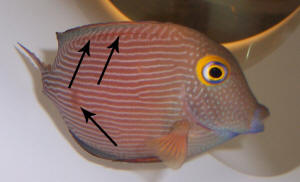
|
|
Tang Problems....11/23/11
<Hello Tim>
I have been reading you site and can appreciate all of the help
you give.
It is nice to have some one to bounce problems off of.
I have a 45 Gallon swa <please, no
abbreves> with 50 lbs. of live sand and 50-60 lbs of live
rock.
I have a wet dry system (Americalreef 150) With a Coralife
protein skimmer.
Lighting is 250 watt MH 14,000K with 96 watts of actinic
fluorescents (T5)
I set this tank up in August with live rock and live sand, I
added 3 Green Chromis and a small cleaner crew.
-5 big Mexican turbo
-5-7 small snails
-1 emerald crab
-1 Cleaner shrimp
I let this cycle for a while and added a cleaner goby in
September. Late September I was in full green algae heaven so I
added a Kole Tang and then later a small hepetus
<hepatus> blue.
Everything has been going extremely well.
SG 1.024 / 77 F / O ammonia
I recently (last week) added a sebae anemone and a maroon clown.
They have paired up nicely in the last 48 hours and seem
happy.
When first introduced, the Kole would act very aggressive to the
clown. ( I expected this)
The blue tang seems to act as a mediator to the too, getting in
between them and seeming to break it up.
Were doing wonderful last night and this morning, eating well and
active.
Got home from work today and the clown is happy in his
anemone , the blue tang is near death, barley moving, lying on
his side. (end is near)
The Kole seems like he cannot close his mouth, also seems
stressed.
Could they have gotten into the anemone?
<Very possible.>
The Kole is bigger than the blue maybe a sting?
I have attached a few pics of the tank.
Any ideas on my Tangs?
<Is really too small a system for these tangs to co-exist.
Even though the Kole Tang is one of the less aggressive
Surgeonfishes, it will battle with its own kind, and possibly
with close relatives.>
Thanks for any help.
<You're welcome. James (Salty Dog)>
Tim
|
|
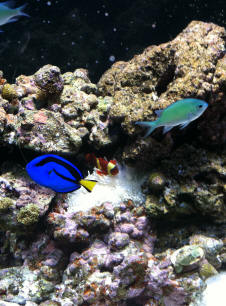 Badly bleached Badly bleached
|
Scopas Tang in quarantine 7/18/11
Hi crew, once again I'm looking for your expert advice. Yesterday I
purchased a 3' Scopas tang. I drip acclimatized him for about a
hour and a half and placed in my 25 gal quarantine tank. My question is
should I have put him in the quarantine tank? I have read conflicting
articles about quarantining tangs. If so, should I keep him in there
for the normal duration of 6 weeks? By the way, my water parameters are
Ph -- 8.2, ammonia -- 0, nitrite -- 0, nitrate -- 10ppm. Thanks in
advance for your help.
Ian
<Some tang genera and species and individuals (depending on apparent
health) are a "toss up" in deciding whether it is of more
benefit to quarantine or simply dip/bath and place immediately in main
displays. I would have dipped this one
Read here: http://wetwebmedia.com/dips_baths.htm
and quarantine it for a week or two. IF there is no apparent behavioral
or parasitic issue, I'd then move it to my main/display system. Bob
Fenner>
|
Ich... reading...
11/11/10
Hi again :) I just added a "Rainbow Tang" to my DT (Too
big for my quarantine tank) and now he has Ich, along with my
Kole tang.
<... and soon all others>
The other fish aren't showing any signs yet but was wondering
what I should do?
<? Have you searched, read on WWM re? I'd get/use CP,
quick!:
http://wetwebmedia.com/crypttangsf4.htm
and the linked files above...>
I have a 150g with a few tangs a Queen Angel and a Zebra Eel. My
QT tank is only 29g... It's a FOWLR tank BTW if that
helps.
Thanks so much guys!
Here's a pic of the "Rainbow Tang"... Do you know
the real name of this Tang?
<... likely A. dussumieri... Read: http://wetwebmedia.com/acanthurTngs.htm
-Jay
<Bob Fenner>
|
|
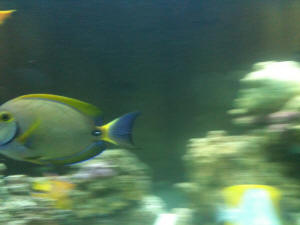
|
Mystery of lost Surgeonfishes
9/1/10
Hi M. Fenner,
<Noel>
I have again a question for you...
I have one customer who lose every surgeonfish he put in his aquarium
and I can't find why he has a 125g tank
no ammonia, nitrites, nitrates are at 10
about 30x the volume of his tank in water flow
no problem with temperature,
tank mate : one Centropyge angel, 2 Australian clown, 3 chalk Basslet,
2 orange line cardinal fish and 2 watchman goby
he had marine velvet last year, but he wait to put other fish and now
all the fishes name above live very well (even reproduce : goby and
cardinal)
he add one Naso tang (die 4-5 days after)
<Mmm>
about 3 weeks after he add one convict tang (die 4-5 days after) the
tangs show no sign of illness, the first couple of days they eat and
move normally, but on the 4 days stop eating and start breathing more
rapidly... by the end of the day stay at the bottom... and die the next
day I asked if he add done something (like a water change) before the
sign appear, but he told me no
I know these tangs are not the easiest... but these 2 fishes came from
QM, and I had them for more than 2 weeks each and they were eating very
well at the store
I ask the customer if maybe the acclimation was done to rapidly, but he
told me that the temperature and the salinity (1.025) was the same as
his tank when he introduce the fishes and that he took about 1h to make
the acclimation
<All sounds, reads as fine...>
he didn't saw any real aggression between the fishes the only thing
he told me about the convict tang was that his dorsal was
more yellow tang white he doesn't have a sump...
<This is a clue...>
so the add of freshwater is done in the tank, but with the help of an
Osmolator, and with ro/di water (0 ppm)
do you think of a raison why small fishes wouldn't have any problem
in his tank but bigger like tangs would?
<I can. The most likely cause of death here is low dissolved
oxygen.
Tangs/Surgeons/Doctorfishes absolutely require high DO... 7-8 ppm... In
fact, I would encourage this person to lower their specific gravity...
this will help with oxygen/gas solubility>
is it's possible that he as electricity in his tank... ground his
tank may be good?
<Mmm, no... the other fishes would be mal-affected as well>
I know he put a lot of corals food in his tank, but the other fishes
don't mind and the tank as only 10 of nitrates...
he as a really good skimmer (Deltec)
I just don't know where to look to find what's wrong, I never
had this kind of problem before with any other customers :(
thank you
<Welcome my friend. There are oxygen testers... and adding a sump
(with its increased volume and air-water mixing) would help as well.
Bob Fenner>
Thank you!!
<Welcome>
I had think about oxygen but with the skimmer and water flow didn't
think it was what was causing the death
<Is only a guess... but my best first shot>
thank you very much for your input :)
I'm going to the MACNA, maybe I'll see you there ;)
<Oh! Yes. Please do look for me, introduce yourself. Will be there
tomorrow night till Sunday's end>
have a nice day
Marie
<And you Marie. BobF>
Atlantic Blue Tang - eye problem -- 06/26/10
Hi again,
A couple of months ago I upgraded my 215 to a 330 gallon. I've been
running a UV sterilizer the entire time. Only my Atlantic Blue tang has
come down with a mild case of Ich. I noticed one of her eyes, when she
moves it around, occasionally displays a pure white membrane behind the
eye. She does not have pop-eye or a cloudy eye. It is actually behind
the eye. I also have a Lavender tang in another tank (400 gallon
established two years now) that displays the same type of symptoms. The
Lavender tang does not show any signs of Ich. Any ideas what this may
be?
<I think just the equivalent of the tapetum lucidum in many
vertebrates>
It is almost impossible to take a picture because it only shows up when
they move their eyeball. When I see this happening, I do notice that
they seem to be twitching their eye.
Your help, as always, is greatly appreciated.
Thanks,
Nancy
<I would not be concerned with this reflectivity. Bob Fenner>
Re: Atlantic Blue Tang - eye problem 6/26/10
Hi Bob,
Thanks for the info. I feel relieved. I've had this fish for over 3
years now and I've grown attached to her. I got her when she
wasn't much larger than a half dollar and now she's probably 7
- 8". I spoil her with the
macros and sushi Nori...
<Ahh!>
I also inquired about a month ago about my other Atlantic Blue Tang (in
my 400 gallon system) that ran into a long spine sea urchin. I let
nature take its' course like you said and the fish is fine and
healthy.
<Good>
One day while we were doing a water change, the sea urchin crawled out
of the water to the top of the tank, and I managed to get a net
underneath it.
It's now residing in the 120 gallon sump - a good place for it.
Thanks again for all your help. I really appreciate it.
Nancy
<Welcome Nan. BobF>
|
Acanthurus coeruleus with skin issues?
6/15/10
Greetings to all at WWM!
<Howsit Jamie?>
I've been treating my FOWLR display tank with Chloroquine
phosphate since April 30th for my quinine resistant strain of C.
irritans. The fishes have all appeared to tolerate this
medication very well and no more Ich after one
week of Chloroquine.
<Yay!>
I've continued this treatment as I learned from Dr. Fishman
that this medication can be dosed continuously in the tank as a
preventative for further reinfection.
<Mmm, I would not do this... with CP or other med.>
My question is in regards to the Atlantic Blue tang, who shows
these "blotches" only at certain times when his skin
turns a darker color.
<Just "stress"... your pic shows a very nice
specimen>
They are not raised or fuzzy. Behaviorally, he is a little more
isolative, and appetite has been decreased. One of his eyes had
some cloudiness but this seems to come and go.
I am wondering if this is due to Chloroquine sensitivity, or is
this a secondary infection.
<Much more the former likely>
My tank parameters: ammonia 0, nitrite 0, nitrate 5, pH 8.2. He
is the only fish showing this.
Thank you for your time and providing this wonderful site to
educate and enlighten!!!
Jamie
<Thank you for sharing! BobF>
|
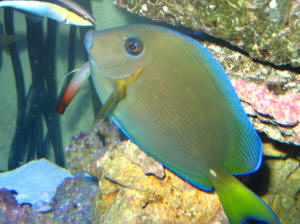 |
|
Re: Acanthurus coeruleus with skin issues? and CP
f' 6/16/10
Hello Bob!!!
Thanks for your reply!
I'm sure you don't remember as you get thousands of
e-mails, but you have a "baby" picture of him when he
was the size of a silver dollar - when I sent a picture of him
with "black dots" where the Ich fell of from the
original
quinine sulfate treatment! He has grown to be four inches big
now, bigger than my Powder Blue tang.
<Neat!>
I don't think he would still be with me if it was not for
your guidance and your web site!
Thank You Thank You Thank You!
Jamie
PS: The Chloroquine phosphate treatment will end in six weeks as
I was wanting to make sure that I have three months with no signs
of C. irritans before stopping. I believe that I got the quinine
resistant strain by stopping too soon.
<I think it (the Crypt) is long gone. Cheers, BobF>
Re: Acanthurus coeruleus with skin issues?
6/16/10
Sorry to go on and on... BUT
How do you recommend I "stop" the treatment?
<Just stop adding the material>
Would you...
1. Just start routine weekly water changes of 15-20%
<Oh yes>
2. Turn on the skimmer
<I would>
3. Add carbon
4. All of the above
5. Do nothing, the Chloroquine will "self destruct"
after five seconds...
:)
Jamie
<Oh! It already has if you haven't been re-adding it.
B>
Re: Acanthurus coeruleus with skin issues?
6/16/10
G-day Bob,
Just for future reference...
I know that we dose Chloroquine at 40 mg per gallon. I've
read that you "re dose" every 7-10 days, but as I was
waiting for my treatment, I've done some additional reading
and learned that Chloroquine "is very stable in
solution"
and I've spoken with Dr. Fishman regarding this and he shared
that you don't have to re dose. At one point, I had 22.8
grams total in my 190 gallons of water which is three times the
normal treatment dose and that was when all
my fishes appetite decreased. So...I guess in a round about way,
if I ever need to treat the fishes for crypt, how would I dose
the Chloroquine to begin with, would I re dose and if so, how
often, and for how long?
Thanks a Million!
Jamie
<Thank you for this valuable input. Am going to be
"splitting up" the Quinine cpd. FAQs today likely.
B>
|
Need Help (No Info 'Need To Read) --
06/13/10
I need help...
<<Okay>>
My tang is looking skinny'¦
<<'¦?>>
Can you tell me what I need to do?
<<Not from the lack of info supplied'¦ The issue may be
a matter of water quality, parasitic infestation/protozoan
infection 'or a matter of starvation'¦ You need to
read here (http://www.wetwebmedia.com/Tangdisease.htm) and among ALL of
the related links in blue at the top of the pages>>
Also what is the best food to feed all kind of fish in tank...is there
a kind of food that will be good for all fish?
<<If the fish will accept it (most do), New Life Spectrum
pelleted food is a palatable and nutritious 'all 'round'
fish food. Your Tang(s) will also benefit from the addition of some
vegetable matter 'I like the Sea Veggies offering from Two
Little Fishies>>
Now I have to put in a lot of different food 'is there one
that has a mix for all?
<<See above>>
Thank you
<<Happy to share'¦ EricR>>
|
Atlantic Blue Tang ran into a Long Spine Sea
Urchin 5/30/2010
Hi,
I have a feisty Atlantic Blue Tang in my 400 gallon that ran into
a large black long spine sea urchin. I could see the broken off
spine protruding slightly from the Atlantic Blue Tang's head,
and it has a chalk white circular ring around it about a
1/4" in diameter (please see attached pictures). First of
all, should I remove the Atlantic Blue tang and try to remove it,
or just let it heal on it's own?
<This latter. Leave this fish in place; the damage will heal
of its own accord in time>
Secondly, what's the best way to get the long spine out of
the tank without tearing down the tank?
<A grasping tool of length at night time, when it is out
scouring the rock, bottom>
He is very fast and has grown very large.
Your help would be greatly appreciated.
Thanks,
Nancy B.
<Welcome. Bob Fenner>
|
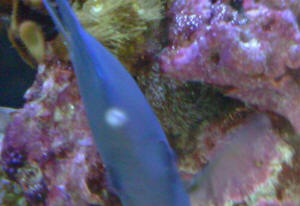 |
Re: Bio-load and wrasse compatibility. Sohal/Tang caudal
spine 1/21/10
injury
Hi Bob,
<Adam>
Sorry for the frequent e-mails, I figured I would keep this in the same
message stream so you know what set up I'm e-mailing about. Last
night I noticed that one of the defensive spines in front of my sohal
tang's tail was 'stuck' in a partially extended
position.
<Does sometimes happen with the Tangs that have mobile spines... not
a worry... Generally corrects itself in time>
I wasn't home for most of the day, but when I fed him earlier in
the evening he looked totally normal. In fact over the week he's
finally gotten use to people being in the room with him and has stopped
freaking out when I come close to the tank. He even begins eating off
the algae sheets before I've finished suctioning the clip to the
inside of the glass (he use to hide as soon as my hand entered the
water).
<Good>
I wasn't even sure what I was looking at first as I've never
actually seen one of those spines extended. He is still behaving
normally, but at this point I'm really worried that he's
somehow injured himself and with the spine extended like that it will
get caught on a rock as he swims around the tank. I also can't find
anything about this particular condition/injury online so I don't
know if it's normal (though I suspect not), if it can heal or if I
need to intervene somehow. The water parameters are all the same as the
first time I messaged you and the only thing I have added since we last
talked are three SPS frags.
Thanks again,
Adam
<Not really a worry. Bob Fenner>
|
Please help! What is happening to my tangs?
12/5/09
Greetings to Bob and Crew at WWM!
I apologize but I'm a bit anxious with the progression of
this Ich infection.
I started Quinine phosphate treatment two days ago and my fishes
are looking...worse?
I've noticed all these spots on the tangs in particular. I
can't describe them, it's as if their scales were
"popped" off and so now the flesh is exposed. My PB
tang and Atlantic Blue tang both look awful but otherwise eating
okay. I've included a couple of pictures for you to see.
Please help!
Thank YOU!
Jamie Barclay
<This appears to be Paravortex grossly... but could be
"environmental" or even another Protozoan complaint. I
would add an anthelminthic to your treatment protocol here. Can
be mixed with the Quinine. Please see WWM re all. Bob
Fenner>
|
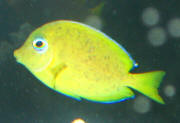 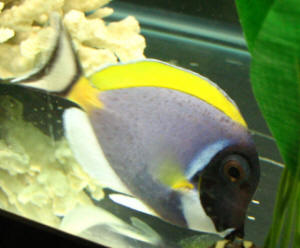 |
Tomini Tang QT??!!??/Quarantining Tangs
11/25/09
Hey guys,
<and gals. Hello Adam>
I purchased a Tomini Tang from the LFS yesterday.
<A nice fish, have one myself, and in my opinion, one of the hardier
tangs.>
I had set up a QT tank with 1/3 new water and 2/3 tank water (from my
display) over the weekend (29 gal tank). I placed 2 softball size
pieces of LR from a tub that I have rock sitting in from previous
systems. (This rock has been sitting with a couple powerheads and at
one point a skimmer running for over a year, this does not include time
the rock was in other systems) The QT tank also has a hang on back
filter with filter floss, about 1/4 a cup of carbon, for circulation, a
Koralia 3
<Geez, 850gph is an awful lot of circulation for a 29. The tang must
be hanging on for dear life.>
and some Chaeto from the main display. My question is will these two
pieces of rock provide sufficient bacteria to keep the tank from
cycling.
<There should be sufficient bacteria present on the rock to allow
denitrification to take place.>
I see now this may have been ignorance on my part, but it seemed like a
perfectly fine scenario in my head at the time.
<Is fine, the bacteria on the rock will quickly adjust to the
bio-load.>
Also I have read up a little more and seen that Bob often suggests to
skip QT on this species? The LFS has had him since Sept. 30th and he
looks healthy, other than some "heavy" breathing tonight
which I think may be result of him staying inside a piece of PVC
that's receiving the full brunt of the Koralia 3.
<I'd get that flow down to 250-260gph max.>
He is VERY shy as well and will not come out to eat red algae that I
placed in the tank, but he has ate some NLS Thera-A pellets.
<Likely not enough cover to make him feel comfortable. Put more rock
in from your tub to build up a cave, but keep in mind they are a little
on the shy side
for a few days.>
Should I monitor for a few more days and if no outward signs of
infection are present, release him or wait the full 4 weeks of QT? I
have about 10 fish in my 400 gallon SPS display tank and don't want
to run a risk of infecting it/my other fish.
<I purchased my Tomini from a reputable dealer who filters his
entire systems with multiple sumps. If one fish in a system is
diseased, he will remove the fish and treat. He will not sell any of
the other fish from that particular system for two weeks. In that
regard, I felt comfortable putting the tang directly into my show tank.
If you feel comfortable in that respect, and the fact your dealer has
had this fish for quite some time with no problems, then I would feel
comfortable placing this fish into your display. The choice is still
yours to make. The last thing I need to hear is "that damn Salty
Dog told me to put the fish in and now I've had a wipe
out.">
I am new to the QT process as I am trying to employ it with the new
large system to avoid any catastrophes. My second try at QT resulted in
the death of 2 Purple Fire Fish.... This brings me to my final
question. The fire fish that were QTed looked great for two weeks and I
was going to release them into the main display tank when I noticed
what I researched to closely resemble in all ways, skin flukes. Small
patches of whitish/clear that moved up and down the fish. I tried to
treat with PraziPro but I was too late I fear, and the freshwater dip I
administered also turned ugly. I had a couple pieces of live rock from
the tub in with the fire fish when they died. I let the tank go fallow
for a little over a month. I then tossed the rock back into the tub
with the rest of my old rock. It has been a little over 4 months... do
I have anything to worry about with the flukes? This rock has a ton of
life on it and in it, brittle stars (several medium size ones) and lots
of pods... close to 200 lbs of rock I would hate to have to sterilize
it by drying it out... Is it infected? or is it safe?
<Should be safe. If indeed they were flukes, they will die off with
the lack of a host. James (Salty Dog)>
Adam
Tanged and confused: Oversized fish, Flukes
10/20/2009
Hi there,
<Hello>
I bought a 55 gallon fish tank a little over a week ago. I bought the
whole set up from a man who had a 20 gallon refugium with gravity feed
hose and a protein skimmer (not sure on the name) My test kits are kind
of old so I have been taking the water to the LFS to be tested and
every time (3x's) it has been fine.
<I highly recommend you purchase your own test kits, less moral fish
stores will tell you that your water is fine to encourage you to buy
more animals.>
I am a little worried a because of the fish that this man had kept in
the tank. He had a Clown fish (about 3 in) a Sailfin Tang (about 4
in)
<The Sailfin Tang needs to find a new home, way to big in the long
run, and likely too big now considering he has been in the tank at least
two years.>
these two he had had for about 2 years and then he had added more
recently (with in the last few weeks) a Blue Tang (1.5 in)
<Also way to large for this tank, although he fits in the tank
physically now, psychological stress can be caused by being kept in
such a small tank.>
As far as aggression goes they are all fine. The Blue Tang hides often
and the other two let her. Though I know I will need to upgrade to a
150 gal or larger in the future or re-home one of the Tangs, for now
they seem to be doing fine.
<I would find them new homes ASAP and research stocking a 55G
aquarium on WetWebMedia.>
The problem I have seen is with the Blue Tang. I have seen whitish
circular spots on her and her belly is looked swollen. She has also
been scratching A LOT and so my hunt for a cause and cure started. I
have been reading up on your site for 2 days now and it sounds like
monogenetic Trematodes though I have been overwhelmed by the amount of
information out there. She swims oddly (no other way to really say
that) spends most of her time hiding or at the top of the tank (often
face down). She has been eating and seems happy enough so that's a
plus. I need help in how best to treat this.
< I would recommend a Prazi treatment in a separate quarantine tank,
there are several products available commercially including PraziPro,
however there are other options for treatment, read here:
http://www.wetwebmedia.com/fshwrmidcuref.htm.>
Also because I bought this as a complete set up I do not have a QT set
up though I am going to set one up today. I am however unsure as to how
to set up a QT in one day'¦ maybe use cycled water from my
tank and add new salt water to my display? Then use the sponge my in my
refugium as a filter in my QT and replace with another sponge though I
do have a 5 gallon refugium I could use (your thoughts on
this)?
<That sounds like an excellent start, make sure to provide some
flow, and during medications you use be sure to make sure the water is
adequately aerated, although the powerhead may take care of that
depending on the tank you set up. Just make sure to pick up a test kit
and continually test this "quarantine" water and administer
water changes as needed.>
Am I off base in any way? Please point me in the right direction. Thank
you for your time.
<I think you have a good start to your research, and I would highly
recommend setting up a quarantine and treating your fish. However, both
of the tangs should be returned or gifted to another aquarium keeper
with a minimum of a 6ft tank for them to be kept in.>
Sabrina
<Good luck,
Josh Solomon.>
Tangs with White Spot (possible Crypt) No Information.
4/27/2009
hi,
<Hello Youssef>
I knew from my friends that your team is very helpful.
<Thank You>
I have 4 small blue tangs in a reef tank, one of them with white
spot
<I need more information to be able to help you. There are three or
four different Tangs that are blue. Additional information such as size
of your tank and what else is in there is needed as well.>
what to do?
<Please reply back with additional information. You can also read
here:
http://www.wetwebmedia.com/ichartmar.htm
http://www.wetwebmedia.com/ichart2mar.htm
http://www.wetwebmedia.com/crypttangs.htm >
<Mike>
Tang health not quite right -- 04/07/09
Hi Crew,
<Campbell>
How are we all today.
<I'm fair to middling, thanks>
I have a fish health question and I hope you can help. Currently I have
a C. Truncatus Bristletooth Tang in quarantine these past 6 weeks. He
has been absolutely fine up until now. What is happening is that he
is
not passing solids faeces anymore, only a light colored liquid, he
seems very agitated but is hanging about in one part of the tank
whereas before he'd be all over the place. Also, he is twitching
occasionally as if something were really irritating him.
<Likely some aspect/s of the quarantine. Most likely either overall
stress or his reflection in the system side>
He has eaten all the algae from the back panel of the QT and gets fed
Ocean Nutrition Formula1, Forumla2, Spirulina and Prime Reef flakes as
well as OSI Spirulina and Omega Super Veggie Kelp flakes. Normally he
vacuums all this flake food up with apparent glee but now he has
ignored it and it's lying on the bottom of the tank.
<Very bad... I would move this fish to the main/display
stat.>
He is a very young fish, I got him when he was about 1 inch and looked
for all the world like an Atlantic Blue juvenile, minus the blue eyes
and in the past 6 weeks he has more than doubled in size and is well
on
the way to full adult coloration.
This change in behaviour and the liquid faeces issue only started
yesterday, until then everything appeared to be fine and there has been
no sign of any disease or infestation of parasites. He is not bloated
in anyway, just looks nice and plump like a normal healthy Tang.
Can you shed any light on what may be his problem, especially the
liquid faeces thing?
Thanks in advance,
Campbell
<Move this fish now. Bob Fenner>
Sick blue tang =( Tang Disease, (Over)Stocking, Reading,
Little Useful Information 2/25/2009 Hay I just have a quick
question about blue tangs <Hi Jake, which "Blue Tang" are
we talking about, the Powder Blue (A. leucosternon), the Pacific
Blue\Regal\Palette\Hippo Tang (P. hepatus), the Atlantic Blue Tang (A.
coeruleus), or one of the other Tangs that happen to be blue in
color?> I bought a nice looking blue tang last week he was doing
fine but when I was cleaning I accidently knocked the rocks and it all
came crashing down. <OUCH!> I was really worried but luckily the
fish survived and as I expected the blue tang got white spot which
didn't surprise me and today when I saw him he had lost some of the
white spot but looks really sick and faded with rapid gill movements I
was wondering what I can do to help him. <Why would a fish getting
white spot NOT surprise you? How long was the fish quarantined, and how
big is it? Acanthurus Tangs generally do not do well in captivity under
three inches. The Powder Blue is a difficult fish to keep under the
best of circumstances, as it is prone to disease, and the Atlantic Blue
Tang seems to be a regular carrier of Ich\Crypt> I have a UV
sterilizer and I tested the water and that's all I check.
<...and the testing results were?...> The tank is only 50 gallons
but he's only small and I will be getting a much bigger tank very
soon I keep him with: Yellow Tang, <Can be
aggressive\territorial> Flame Hawk fish, <Future Trigger
food.> Wrasse, <What kind?> 2 Clark's Clown fish,
<Potentially aggressive and territorial, especially in such a small
space, future Trigger food.> a very small Damsel, <Another
potentially aggressive, highly territorial fish, also future Trigger
food> and a very friendly bruiser Trigger. <.?.. What kind of
Trigger? Do realize that Triggers get BIG and MEAN. It may be friendly
now, it is not likely it will stay that way.> I know my tank is way
too small but my new tank will be about 150 gallons <If you are
getting a new tank, why buy all of these fish now? Also, with your
stocking list, 150 gallons is probably too small> All the fish get
on good except the yellow tang can be a bit bossy to the blue tang
<I'm not surprised, just wait until the Trigger grows up a
bit.> <Jake, this tank is grossly overstocked with some very
inappropriate fish. I'm suspecting your Tang was not quarantined;
this, coupled with the fact some of the blue Tangs I mentioned above
are as close to an "Ich Magnet" as possible, and being kept
with fish that are "bullies", and a poor diet, probably
pushed this fish over the edge. You are going to have to get the blue
Tang out of the main tank and into a hospital\quarantine tank and then
observe\treat for disease as required. You are now going to have to
keep a close eye on the rest of your livestock to make sure none of
them get it as well.> And another thing, the blue tang doesn't
eat the Nori that I give to the other fish but he loves brine shrimp
and Mysis shrimp is he getting sick from a lack of nutrients? <If it
is a young fish, it needs to learn to eat Nori, as it is not
"natural". Given enough time and assuming it survives, it
will learn to eat it. Brine shrimp are good to help teach a fish to
accept a captive diet, but are about as nutritional as popcorn. Mysis
shrimp are much better. You may want to try adding some other greens
like algae flakes or "Emerald Entree".> Any
info would be great <Start reading here for Tangs:
http://www.wetwebmedia.com/tangs,.htm , here for Triggers:
http://www.wetwebmedia.com/marine/fishes/triggers/index.htm , and here
for anything and everything about disease, quarantine etc:
http://www.wetwebmedia.com/mardisindex.htm Jake <Mike>
Lipstick Tang Quarantine --Naso Tang Quarantine -
11-12-08 Crew, <Mike here tonight> I have so appreciated
all your help with my tanks throughout the years. <Glad to have
helped!> I am scheduled to pick up a new Naso tang from the LFS this
afternoon. I was wondering about the benefits/problems with quarantine
in my situation. I have a 20 gal QT and I am not sure if it would be
more stressful than it is worth to put a 4" Naso in such a small
QT. My 180 display tank is very lightly stocked at this point and I am
considering just doing a fresh water dip and adding him to the display
so that I don't subject him to the stress of a tiny environment.
Would you or would you not place the Naso in the QT? <Would
definitely quarantine - tangs are notoriously crypt ridden. At least
treat prophylactically for crypt for at least 10 days if you want to
shorten the quarantine time> Thanks again for all your help,
<Anytime - pay me back by participating in our newly revamped
forums! bb.wetwebmedia.com> <<Um, no "pay back"
necessary... but if desired, please do support us by visiting our
sponsors. -Sara M.>> Joe
<M. Maddox>
|
Yellow Tang 11/04/08 Hi WWM crew, I
appreciate your time and effort in responding to reefers
questions. Thank you. <On behalf of the team, your welcome>
This is my first time posting, so I have a 65 g and its been
running fine for 4 months. I currently house a 2" yellow
tang and a 2" hippo tang, and I plan on upgrading to a
larger one once they get bigger. <What other inhabitants do
you have that may be picking on the fish?> I've had the
yellow tang for 2 months and its been beautiful, I feed him green
Nori and red algae, brine shrimp and Cyclop-eeze. <Sounds good,
but I would personally switch out the brine shrimp for Mysis
shrimp. They are more nutritious. Brine shrimp have the
nutritional value of cotton candy> One night the yellow tang
turned pale, but it was fine since then. <They do turn
different colors at night.> Its dorsal & pectoral fins are
starting to have some ragged edges, and doesn't seem to be
very healthy. Ammonia - 0, nitrite - 0, nitrates - 5, ph - 8, kH
- 10, calcium - 450, magnesium - 1350, am I missing an important
parameter? Do I need to test for phosphates? <As a precaution
and to start a good habit, I say yes. Phosphate development in
reefs is something you should keep an eye on. But I don't
think it would cause any issues with your little fishy here>
Here's a picture in Sept- no rugged edges on fins, no marks
on face -<<see below>> Here's a picture in NOV -
rugged edges on fins, and face is losing colour <<see
below>> Please Advise <It doesn't look like your
water parameters are to blame, I would first assume that there
was something fighting and nipping at it. Are the tangs getting
along? Secondly I would worry about poor nutrition (as far as I
can see in the pics the little guy is very thin) or some
sickness. I would watch for any aggression and supplement the
feeding with garlic soaked spectrum pellets to make sure that
he's getting all the nutrition needed> Derek
<Jessy>
|
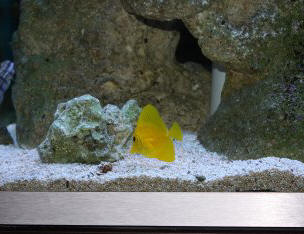 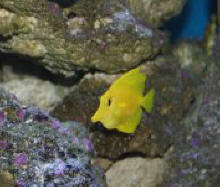 |
Blue hippo tang and powder brown tang, hlth.
9/28/08 I recently noticed my blue hippo tang scratching the
left side of his face on a rock. Upon looking at him close I notice
three micro white bumps all in a exact straight line, needle point
size, <Mmm, most likely evidence of neuromast destruction... aka
HLLE> and same on my powder brown tang but he is not scratching,
what do you suggest? They are both swimming great and eating like crazy
between Green algae and brine shrimp, blood worms, and krill. Troy
<Read here: http://wetwebmedia.com/HLLESWCauseF.htm and the linked
files above. Bob Fenner>
power brown and blue hippo tang, dis., reading
10/1/08 I have powder brown and blue hippo tang that were both
seen scratching so I took a closer look and saw very few salt like
granules on their bodies looks like crypt but not sure. Does crypt look
anything like HLLE? <Mmm, not really... the latter can be evidenced
by small, discrete whitish dots, but is almost always symmetrical, in a
pattern, masking the "pit organ system" of the fish> Last
night looked worse than today, should I just raise heat and lower
Salinity or get them out of tank and do a fallow as soon as possible?
<... you should read> I also have a clown tang, a porcupine
puffer, and a clownfish with no problems that I can see all fish are
eating great and swimming great in a 100 gallon tank 60 pounds live
rock. <... a pic might help here... Otherwise look at ours. Peruse
here:
http://wetwebmedia.com/mardisindex.htm And reading re the species
you're keeping... the Clown and Powder Brown Tangs are very
susceptible to protozoan and environmental troubles... as you'll
see, are seeing. Bob Fenner>
Re: Blue hippo tang and powder brown tang... and other
copper sensitive fishes -- 10/5/08 I diagnosed my fish of
having crypt. I have put all fish in a 35 gallon plastic container, and
letting the tank go fallow. I am treating with copper ( Cupramine). I
am having a heck of a time keeping the ammonia down. I am using ammo
lock and Kordon Amquel plus and doing daily water changes almost need
to do it twice a day. There is a blue hippo(3 inches), a powder brown(4
inches), a Porcupine puffer(5 inches), and a Foxface(3 inches). I feed
real lightly. Can you suggest any other good ammonia remover? Also
after five days of copper treatment (keeping the level at .50) the
whole inside of the black plastic container was lined with tons of
white like elongated salt like substance they are real easy to brush
off any ideas what this my be?? I will try to get a pic if it forms
again before I remove it. Troy <... wouldn't treat these fishes
with copper... read re Chloroquine... quick. BobF>
re: Blue
hippo tang and powder brown tang 10/6/08 Where can I find this
stuff I can't find any place on the web to buy it? Thanks, Troy
<...? I see it in many places putting in the term: "Chloroquine
for sale". B>
Powder blue quarantine 9/20/08 Hi Crew
<Wayne> Couldn't find an answer to my question on the site.
Hope you can help me out. <Me too> I just bought a 4"
PBTang...been at the LFS for 2 weeks and looks healthy. Have him in a
40 gal QT. My question is about feeding. I plan to feed dried Nori, red
algae, and Gracilaria (all soaked in Selcon)..as well as occasional
Form 1 & 2 pellets, and New life Spectrum pellets. I also have this
"Jungle" anti-bacteria pellet fish food. I've read about
the beneficial bacteria that reside in the guts of PBTs. Based on
this....should I not feed this anti-bacterial food? <Mmm, don't
think this will be an issue. The infauna of use are actually Protozoans
mostly> What if the fish displays a bacterial infection...would you
still not feed this food? <Such "infections" are actually
exceedingly rare... How to put this a bit differently than usual... By
the time such microbes "show up" it is almost always too
late... they're mainly decomposers, not pathogens per se> Thanks
a ton. You guys/gals are great! <Mmm, myself, fair to middling.
Cheers, BobF>
| Sick tang, social, env., Acanthurus...
08/28/08 Hello Crew, Thank you for all your help in the
past, it has been invaluable. I noticed about a week ago my Orange
Shoulder Tang was getting a few "discolored spots" on his
body. <I see this> It seemed to be getting worse by the day
until today it seems as if it has covered most of his body with the
exception of fins and head. It doesn't appear to have a texture
or any depressions/lesions. Each spot just seems to have a lighter
coloration than what is normal. I looked in The Conscientious
Aquarist and on this site, but am still uncertain. I have included
a pic taken this am. None of my other fish are affected (as of
yet). Any thoughts? <Something environmental... psychological
perhaps...> 125 g reef tank sg-10.25 calcium- 450 KH- 9 nitrate-
0 nitrite- 0 ammonia- 0 phosphate- 0 1 Blue Chromis - Chromis
viridis 1 Green Clown Goby - Gobiodon histrio 2 Pajama Cardinals -
Sphaeramia nematoptera 4 Blue Streak Cardinals - Apogon
leptacanthus 2 Firefish Gobies - Nemateleotris magnifica 2
Saddleback Clownfish - Amphiprion Polymnus 1 Sixline Wrasse -
Pseudocheilinus hexataenia 1 Lawnmower Blenny - Salarias fasciatus
1 Dusky Jawfish - Opistognathus whitehurstii <These three above
may be harassing this fish> 1Royal Gramma- Gramma loreto 1
Dejardin's Tang - Zebrasoma desjardinii 1 Orange Shoulder Tang
- Acanthurus olivaceus 1 Chocolate Mimic Tang - Acanthurus
pyroferus 1 Yellow Tang - Zebrasoma flavescens <Or these other
Acanthurids> ---------- 20 fish total <Too much, mix for this
volume...> thanks in advance, Alan <I would definitely be
moving this fish elsewhere... Someone/s' bugging it too much.
Bob Fenner> |
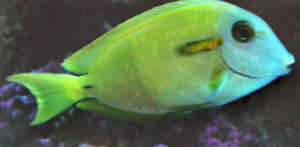 |
TWA Tang hlth. w/ copper... using WWM 8/17/08 Hello, I
need your help, I have a small Atlantic blue tang that's breathing
very fast. <Acanthurus coeruleus... not easily kept as individuals,
in small hobbyist settings...> I had it for about 2 months now. I
just recently tried treating it with copper <...> thinking it has
Ich in it gills. but stopped the treatment after 3 days because the
tang was looking really bad. Look like the tang was stoned laying on
it's side. It was really slow and sluggish. <... had you
read> I was concerned about the tang getting too much copper in
it's system. After I stopped the copper the tang now won't eat
but before the treatment he was eating really good. what do you thing I
can do. I do 2 gallon water change every day. Any suggestions? Thanks
JOE <For you to start reading... on WWM re Copper use and Tangs at
least... Do I have to do what you should have already? Start here...
and soon: http://wetwebmedia.com/crypttangs.htm and the linked files
above... Bob Fenner...>...>...>
Tang In Trouble (Mystery Malady or???) 7/13/08 Hi, <Hey
there! Scott F. in today!> I have had a Hippo tang for about 6
weeks. Three weeks in quarantine; three weeks in the main tank (95 gal;
asst corals; several misc. fishes). <I commend you on embracing a
quarantine procedure!> Since I placed it into the main tank, he has
been mostly hiding in the live rock, with an occasional venture
outsides this protection. For the past few days, he has been very
lethargic. If finally have been able to "capture' him and
place him in a QT. He is on the verge of death, but I would like to do
whatever I can to save him. Any suggestions? Thanks, Fred <Well,
Fred, general lethargy can be the result of many different potential
issues, ranging from poor environmental factors to disease. You'll
have to do some detective work and ask yourself some questions here. I
don't have much to go on. I'm assuming that the fish was eating
well and showing no signs of illness during the quarantine period,
correct? It is not uncommon for a fish to hide for some period of time
upon introduction to his/her new home. However, for the fish to be in
such severe state of lethargy, there must be something else going on.
Is there a "bully" in your aquarium that is harassing this
fish? Are all primary environmental parameters (temperature, specific
gravity, pH, ammonia, nitrite, nitrate) within acceptable limits? Is
this the only fish in the aquarium that is acting in such a lethargic
manner? Are there any other telltale signs of disease, such as rapid
breathing, discoloration, excessive mucus, bumps, spots, or other
obvious body traumas? Has the fish been eating with any degree of
regularity? I think that you're going to have to remove this fish
for closer observation and possible treatment, if there is a disease to
treat. Quiet conditions and stable environmental parameters in the
quarantine aquarium may help bring this fish back, but it is hard to
know. Administering a vitamin product, such as Vita Chem, into the
quarantine aquarium's water, might help perk the fish up a bit.
Before you begin bombarding the fish with drugs, it's important to
know what's going on, of course. Like I mention above, it's
really tough to diagnose this fish based on the information that you
described. I'd key in on either some illness, or obvious trauma as
a culprit. If the condition was caused by environmental factors, the
other fishes in the aquarium would have showed signs. If it is an
obvious disease, such as Ich, there likely would be other fishes
affected. In the end, you're going to have to get this fish into a
quarantine aquarium and observe him/her closely before deciding on your
next course of action. Sorry I cannot give you more specific advise,
but I hope that the questions that I asked, and the fish health
resources here on WWM, help you use deduction to determine what is
wrong with this fish. Good luck! Regards, Scott F.>
| White dangly things on Tomini Tang -
05/31/08 Hello! <Howzit> I have a little problem
(hopefully little). I came home from work today I noticed 3 white
little dangly things hanging off my Tomini Tang. There are two to
the upper right of the eye, and one to the lower right of the gill.
Sorry, this is the best pic I can get - Ernie is a fast little
bugger! They look like little bits of white thread about 2-3 mm
long. My 6 month old tank is a 125 gal FOWLR (to be reef in another
6 or so months). Its stocked w/ the tang (I've had him since
the beginning of March), 3 Randal's Damsels, 1 Oblique Lined
Dottyback, 45 or so snails (Cerith, Nassarius, Astrea), 45 hermits
and 2 Mithrax crabs. The damsels and Dottyback are the newest
additions (3 weeks in display after 4 weeks in qt). As of yesterday
all appeared healthy. Last night parameters were: SG - 1.025, temp
- 80.5, ammonia - 0.0, nitrite - 0.0, nitrate - 0.0, ph - 8.4, Alk
- high (red sea test), calcium - 375. I did my usual weekly 20%
water change using RO water mixed w/ Tropic Marin mix (let sit for
48hr before using). During the water change, I cleaned my skimmer
& fuge/sump. In the process of doing so, I dislodged
(accidentally) a bunch of Syconoid sponges that lived in between my
sump baffles. They were chopped up in the return pump. Could these
stringy hanger-ons be bits of sponge? <Mmm, possibly, but I
don't think so> I doubt it, but one could hope that its
nothing serious. If it is something more serious, what to do?
<Punt... I'd hold off on all treatments, moving...> I
have a qt tank, but its currently in use. My new Copperband
Butterfly & Longnose Hawkfish are qt-ing as we speak. They have
2 1/2 weeks left before they will be cleared to enter the display.
<I'd place them, per schedule> I appreciate any help that
you can give me. Thanks for your tireless efforts to help us all.
Sincerely Pavlo <These suddenly appearing bits are likely
spurious... will likely dislodge themselves on short notice... Bob
Fenner> |
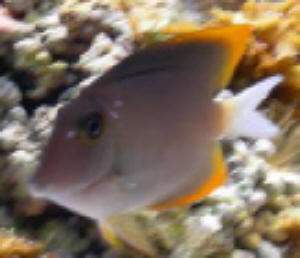 |
Which tang? WWM reading?
5/28/2008 I introduced a new
tang in my 8 week old 75 reef gallon tank on Friday. He was not QTed.
<... mistake> He swims and eats, he's a little shy though. On
Sunday I noticed small white speckles on his fins. (not his dorsal or
ventral fins) well he's eating, and he doesn't have theses
spots on his body. I have a really bad feeling its Ich. I have 3
Chromis and a scooter blenny that are showing no signs...yet. What do
you suggest? <Reading. Start here:
http://wetwebmedia.com/crypttangs.htm and the linked files above. Bob
Fenner>
Black Spot on Atlantic Blue
Tang 4/25/08 I want to first off say
thank you for all the help you and your website have given me. I
recently lost my UV light for about a week and was waiting for the
replacement to arrive. During that week I was out of town and when
I got home I noticed a few things. One was this large black spot on
my Atlantic blue tang about the size of a small pea. I attached a
picture I hope you can see the spot. <I do> I looked up Black
ick but I do not think that is it. Do you have any suggestions of
what it maybe? <Looks very much like a "recovery area"
from a physical trauma...> Another thing I noticed was since my
UV had gone out I now have this dark green almost black film on all
my flex hose and my skimmer is working overtime. Any ideas of this
blackish green film? <Microbes of various sorts likely... will
go with the lamp replacement> It is not on anything but the
hoses and plumbing nothing in the tank. Thanks Again Brad
<Not to worry here... Bob Fenner> |
|
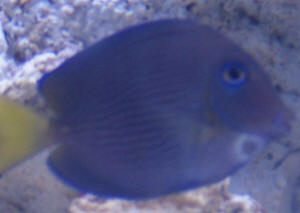
|
| Bloated Yellow Mimic Tang,
3/22/08 About a week ago I noticed my
juvenile mimic tang is very bloated (see picture attached). <I
see this> He ate has been eating this week, but did not eat
anything this morning. I have had this fish since November 2007. He
is usually pretty active. For the past day or so, he stays hidden
most of the time. Do you have any clues as to what could be wrong?
Is there any treatment? <Mmm, perhaps a gut blockage, could be a
form of egg-binding...> 7 month old, 75 gal FOWLR. Fish include:
Yellow mimic tang, imperial angel, <Needs more room than
this> coral beauty, tomato clown, Sailfin tang, sand sifter
Gobi. Water conditions: NH4 - 0, NO2 - 0, NO3 - 4ppm, pH - 7.9,
<A bit low> PO4 - .07ppm, salinity 1.026, dKH - 8.7 <I do
see quite a bit of BGA/Blue-Green algae in the pic as well... it
could be that this Acanthurus has swallowed too much of this... and
is being mal-affected... There are cases where the addition of
Epsom Salt can "free up" such apparent swellings. Do use
the search tool on WWM:
http://wetwebmedia.com/WWMAdminSubWebIndex/question_page.htm and
read the cached views re. Bob Fenner> |
|
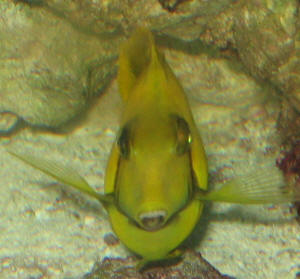
|
Swollen mouth and funny tongue tang 3/5/08 Hi, I
purchased a 3 1/2 in clown tang about 5 days ago, when I brought him
home, he looked great, was eating well and exploring the tank. I have a
55 gal aquarium <Too small for Acanthurus lineatus> with the plan
to move him into my boyfriend's 150 gal aquarium once he grows a
little larger. <Oh!> Today he developed a swollen mouth and
almost looks like his tongue is moving in and out of his mouth
vigorously. His color has gotten darker since this has developed and he
has become a lot less active. <Bad signs> I have done Ammonia(0
ppm), pH(8.0), Nitrate(10 ppm), Nitrite (0 ppm) and Salinity (1.024)
tests, I don't think any of those things are the problem. I do have
several different species of anemones in my tank, including
Condylactis, carpet, and a long tentacle. <... not a good mix. See
WWM re Anemone Compatibility> Could it maybe be a sting from an
anemone? <Mmm, yes> No other fish in the tank (pearly Jawfish, 2
percula clowns) are showing any signs of disease. Any idea what could
be wrong with my clown tang? If so what would you recommend to treat
him? Ashlee <If you have another stable system, I would move this
fish. The more likely cause of the trouble here is/was collection
damage... shipping, what have you... Only time will tell whether the
specimen will self-heal. The prospects are not good. Bob Fenner>
|
Tang spots 2/16/08 Hi Crew, <David> I previously posted ...but after
over 2 weeks the "issue" keeps returning. <I see>
I have a 3"-4" Scopas Tang that I've had for about
2 months. Starting about 3 weeks ago he displayed flashing,
periodic scratching, heavy breathing, then several faint
soft-edged spots just in front of his tail( in order of symptom
appearance). First it was only on one side, but within a couple
of hours it was on both sides. The spots progressed into a larger
"patch" made up of the spots. The patch/spots only
appear above his tail.( see pic) <I see this> I quarantined
all of my fish and treated with QuickCure ( Formalin &
Malachite Green). Within minutes of the first dose the Tang
looked much better - normal color and patch seemed less apparent,
less labored breathing. 3 days of QuickCure ... filter in. Next
day the patch returned ( approx same location)! Complete tank
cleaning and 3 more days of treatment. Again, Tang looked much
better - one might even be tempted to say he looked
"cured". Again, insert carbon filter ...24 hours
...white spot, same location ...with labored breathing! Other 3
fish removed to a second QTank ( no signs of disease). So,
I've started the 3rd round of treatments with QuickCure.
Today is day 2. <I would cease this exposure... too toxic, not
likely to effect a cure> My question is ...is this Ich or
Velvet or some other nefarious ( I threw that in for drama)
parasite? See attached picture. The patch has been more distinct,
but that's what he looks like today. Ich, Velvet, Other ...?
<Other> Suggestions on treatment alternatives? <Time
going by, careful observation> A beer to the one who
successfully gets this Tang "cured";) <Oh!> A
sincere thanks for your time and thoughts. David <This tang is
damaging itself by "flicking" the tang on this, its
favorite side... likely in response to its own reflection
(internally, inside the tank). Try placing a piece of paper on
the side it seems to stay most on "jousting" and be
patient. Bob Fenner>
Re: Tang spots
2/17/08 Hi Bob, No beer awarded yet
... but I'll put one on ice just in case;) <Ooh, stop
teasing> I will try the paper suggestion, but new symptoms
have appeared! The Tang has 5-6 quickly developed individual
soft-edged spots on one side of his "chest" (
resembling the original spots just above his tail) and now
appears to have something ( not quite cloudy) on both eyes!
He's stopped eating, and over the course of the day the spots
on his chest have gone through a transformation from slightly
visible to distinct and now have diminished to the point that I
can only identify (1) spot. I've observed each morning he
seems to look great, <Am curious as to whether these
spots/marks re-appear everyday, grow in number> or at least
good, but his condition diminishes with the day. While I
haven't witnessed any "jousting", his temperament
could be characterized as more aggressive with frequent bullying
for a corner position with the bi-color Damsel that was sharing
the QT (these fish have been removed to QT2). <Good> Sans
tank-mates, he has just been slowly swimming around the tank.
Also, I have seen a marked improvement whenever the Tang is
receiving the QuickCure. <Perhaps akin to you gargling
seawater for a sore throat...> Each time the spot(s) seems to
retreat, color becomes vibrant and his overall health looks to
have improved - sometimes to the point of "cured".
Assuming I am up against a parasite, I dosed the fish today and
over-dosed ( 20%) when spots returned, monitoring for any signs
of distress. Several hours have gone by and again he seems to
have improved after receiving medication! <Dosing... the
formalin/copper? Where? Not in the main tank I hope/trust>
Tell me to "take my foot off" the QuickCure and I will
...but I fear the beer might never be awarded:( <Me too>
Thanks again for your thoughts. David <Do you have access to a
microscope... even of low (a few hundred X) magnification?
Facility of using? I would be chary of continuing the exposure to
the active ingredients of QC with this or any other Tang, fishes
period... If it can be determined that this is indeed a parasite
definitively, more specific (less general biocidal) treatment may
be proscribed... Otherwise, I still stand with my
non-high-confidence guess that the root of the issue here is
environmental. Bob Fenner>
|
|
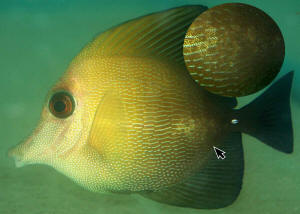
|
Re: Re: re: Tang spots
2/17/08 Hi Bob, The spots come
and go, but seem to have a "life expectancy" as
they change throughout the day. <A useful bit of
data> I don't have a microscope ( put that on list
of things to buy next). However, the spots on the
Tang's eyes appear to be a small ( grain of salt size)
soft-edged sphere(s) with what look like tendril-like
branching roots extending out randomly. <Interesting...
perhaps a trematode...> Spots on the abdomen came and
went and have been replaced by a new spot. Several smaller
white grains have appeared around its eyes. Pectoral fins
have a "moldy" look to them which also has come
and gone over the course of the day. Unbelievably the Tang
is still hanging in there, but I suspect its life
expectancy has already been determined:( <Am not
generally subject to much belief in pre-destinies> Any
advice ...a last ditch attempt ...some rare experimental
medication recently developed from the stamen of some
endangered Amazon flower? The fish has shown real heart
...I'd hate to give up on it. Thx again. David
<Where is this specimen again? If not in the main
display, I would make the bold move and summarily
pH-adjusted FW dip and move it thus. BobF>
Re: Re: Re: re: Tang
spots Thanks for the quick
reply Bob. <Welcome David> ...freshwater dip (ph
adjusted) until any signs of distress or 6 minutes ...which
ever comes first? <Yes... aerated> Then move to
display tank? I see where you're going with this
...seems worth a try. I'll let you know what happens
...TBC. Thx. David <Should all be fine.
BobF>
Re: Re: Re: Re: re:
Tang spots Good morning Bob,
<David> As prescribed, FW dip about 6 min, then right
into the display tank. Rough night ...but Tang is alive (
see attached photo). However, it's looked good every
morning ... only to look horrible by afternoon and
evening:( Spots seem to have disappeared ...except for
several on its left eye. Small specks with some cloudiness.
<Patience my friend> Lights out for the day... it
couldn't possibly be something that is part parasite
with a photosynthetic ability? <Not likely, no> Next
problem ... eating. This fish is very thin and has refused
brine shrimp(!), Nori and an algae based feed ( Source
One?). <Try Spectrum pellets of small size/diameter...
remarkably palatable> ?, the other 3 fish, False Clown,
Bi-color Damsel and a 3 Stripe Damsel ...dip and return
home or leave in QT? <I'd leave them for now>
Here's hoping I need to FedEx a beer to some distant
state;) <Mmm, what town do you inhabit? What brand of
beer?> A sincere thanks for your assistance thus far.
<Welcome> PS - I have a Chiton that I've had for
about 2 weeks. I didn't QT for fear of it starving. How
does one, or do they, ensure that nothing "rides
in" on this new addition? FW dip? <Not to worry
here... this planet, life is not discrete in such
vectoring/conventions... all is a matter of
"degree"... With other tendencies, influences in
your favor, all will be well here. Please take a scan:
http://wetwebmedia.com/mardisease.htm This idea set is one
of my few important models to grant others> If so, how
long? Thx. <I would not FW dip most any invertebrate
group... there are exceptions, but they are but few>
David
<Bob Fenner>
|
|
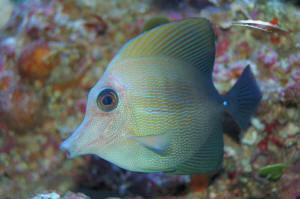 Ahhh, mas mejor. RMF. Ahhh, mas mejor. RMF.
|
Re: Re: Re: Re: Re: re: Tang
spots 2/19/08 Bob,
<David> Do you have a cell phone number in case
something happens to the tang really early in the
morning? <Heeeee!> Just kidding;) Seriously,
thx for the great advice. I'm sure The Crew has
saved many... while educating the care givers on the
diverse habits and needs of all these wonderful LFS
purchases;) <It is indeed... a mission, a cause
célèbre... expression of the desire to share
awareness, inspire other folks to appreciate, enjoy,
have success... twixt themselves and the
living/aquatic worlds> I'm located in Western
Massachusetts, 5 minutes from Amherst, MA ( 5
colleges - Amherst, UMASS, Hampshire, Mt Holyoke and
Smith). <Mmm... a bit far from HI and San Diego,
Ca... But am hopeful we will indeed meet in
proximity> No matter the outcome you have earned
your beer. Address? <Thank you, but let's wait
till that time of meeting. Knowing that you and your
Zebrasoma have gained is sufficient thanks> PS -
careful when you open it as the contents were
probably subjected to rapid changes in motion;) Paix
David <Salutem dicit, Bob Fenner>
Re: Re: Re:
Re: Re: Re: re: Tang spots Bob, today's pic entitled: "Tang
foraging" ...evidence of your successful
guidance, my thanks ...and the Tang's recovery (
I'm sure it thanks you also). <Ahhh!> If
our paths ever cross I owe you a gallon of beer.
<Almost getting worth jumping on a cross continent
jet!> Now I'm off to click a couple of WWM
sponsor ads;) Sincerely, David
<Congratulations on your success David.
BobF>
|
|
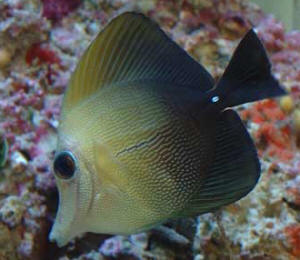
|
|
|
Powder Blue Tang/Health 2/6/08
Hi, <Hello YJ> Im a
newbie at this. I have the responsibility of taking care of our
aquarium while my hubby is gone. <Hoping not for long.> We have a
200 gal, water tested fine yesterday, <Not necessarily indicative of
good water quality.> temp is about 78. Yesterday my Powder Blue Tang
looked distressed, this morning he is way down on the bottom behind the
rocks and I think he is dying. <Me too.> I watch the fish very
closely every day for signs of anything unusual. We have a Yellow Tang,
Blue Damsels, Fox Face (looks stressed today). My Blue Tang has been so
happy and a pleasure to watch, I don't understand what's going on.
Thank you, Im glad I found your web site, very informative. <I'm
thinking this is an environmental problem more than anything else. Your
tank is certainly large enough but tangs do require pristine water
quality for continued good health. You mention nothing as to your
maintenance schedule, filtration system, diet, etc. Need more info here
to provide a better answer. Do read here on the Powder Blue Tang.
http://www.wetwebmedia.com/powdbluetg.htm James (Salty Dog).> YJ
Texas
|
Olivaceus Tang
hlth 2/2/08 Hi guys <B and
L> Your website is great and has provided us with many helpful
tips and suggestions. <Our hope> We are located in Aus, and
have a 10 x 2 x 2 tank, which we added a large Olivaceus/Orange
Shoulder tang to a week ago. <Am out in some of this species
prime territory (Hawai'i) currently...> He seems to
scratch and smack himself in the head with his fin and has had
these black marks appear recently (see attached). <I see...
typical "break down" syndrome...> I lost a tang
which had very similar marks on its body a few years ago. He is
swimming and eating well. Other tank mates are Blue/Regal tang,
Lipstick tang, Sailfin tang, Emperor angel, Blue Face angel, Blue
Spot Sting Ray and Zebra eel. <Yikes... I do hope this system
is huge> Testing all our parameters I cant find anything out
of the ordinary. Can you help in any way, by letting us know what
it could possibly be and how to treat it? Thanks in advance for
your time. Brett and Leanne <As you state, this specimen is
feeding well... I would introduce and feed (likely exclusively)
Spectrum pelleted foods to all the stock you list... Please read
here re: http://wetwebmedia.com/foodsppt1.htm This food by itself
will greatly bolster the immune system of the Acanthurus, and
help to lessen aggressive behavior/stress amongst all... Bob
Fenner>
|
|

|
Tang/Health 12/18/07 Hi Bob. <Hi Lori, James with you
today.> I'm hoping you can help me. I'll start with a little
info regarding my tank. I have a fish only tank that I started about 5
months ago. I have one Three Stripe Damsel, 1 Yellow and Blue Damsel
and added a Yellow Tang, Scarlet Cleaner Shrimp, Chocolate Chip
Starfish, and 2 Turbo Snails approx. 1 month ago. My water has
maintained good quality. <What size tank are we talking about
here?> The salinity has been kept at 1.021 and temp of 80. About 4
days ago I noticed the tang acting funny (but eating well). He was
scratching himself on the rock decorations and the cleaner shrimp was
going crazy cleaning him (more than normal). <Not good.> When I
looked closely I finally noticed the black specs. Luckily I was able to
diagnose him with black Ich rather quickly though your info website. I
spoke to the aquarium shop about freshwater dips and anything else I
could do. I'm very attached to this fish and so worried about him.
She advised a 1 minute freshwater dip in dechlorinated water at the
same or slightly warmer temp as the tank and that I should lower the
salinity down to 1.016 and raise the temp to about 83. I tried to
adjust the tank salinity and temp over the course of a little more than
24 hours (I think too fast). I then got the freshwater dip ready at
about .2 degrees warmer than the tank. I put the tang in the dip, he
sank to one side then jumped up and moved around then just under 1
minute he began to breathe rapidly and looked like he was beginning to
stress and I removed him immediately. The spots were gone within a
couple hours of the dip. This was done 3 days ago, and since then, he
has not acted well. The first night he would swim in circles. He is not
eating at all. He looks as though he has seizures every now and then.
He goes through periods of rapid breathing. He will swim into the
corner as if he is trying to bury his nose in the bottom. I feel
awful!!!! I'm beside myself and don't know what to do for him.
I did not let the salinity stay that low. Over the course of these 3
days I raised it back to the normal level and the water temp has stayed
at 82.2. By the way, with the change in the water, I killed my cleaner
shrimp. I woke up the day after the tangs water dip and the starfish
was on top of the cleaner. I was devastated and cried for 2 hours. The
tang and the cleaner were 2 peas in a pod!.... Can you help me? What
did I do wrong? I'm praying that my tang will pull out of this but
my hope is deteriorating each hour that he goes without eating. What do
you think are his chances? <Sorry to say Lori, but I'd be
surprised if the tang is still alive when you get this.> Thank you
in advance for any help you can give me, or any advise so that I do not
make the same mistake again. <Lori, tangs are not the easiest fish
to keep for starters. They are "Ich magnets" so to speak. You
did not mention quarantine so I'm assuming the fish was never
quarantined before going into the main display. Do read these links and
related files in each link. http://www.wetwebmedia.com/YellowTang.htm
http://www.wetwebmedia.com/Tangdisease.htm
http://www.wetwebmedia.com/ca/volume_3/cav3i4/quarantine/Quarantine.htm
http://www.wetwebmedia.com/QuarMarFishes.htm
http://www.wetwebmedia.com/quaranti.htm
James (Salty Dog)>
Lori
Surgeonfishes: Tangs for Marine Aquariums
Diversity, Selection & Care
New eBook on Amazon: Available here
New Print Book on Create Space: Available
here
by Robert (Bob) Fenner |
 |
|
|

